#source: mr welch
Text
FEFERI: No, -Eridan, “c)(ummer” means t)(at Sollux is our frond, not that s)(arks find )(im tasty.
#Source: Mr Welch#submission#homestuck#incorrect homestuck quotes#feferi peixes#eridan ampora#mod nepeta
65 notes
·
View notes
Note
Hello there ^^ have you posted the list of books you're reading before by curiosity? If not would you mind sharing? I'm curious, if that's ok with you!
For those who haven’t seen this post, one of my New Year’s Resolutions is to finish my reading list. I picked 32 books/ stories from recs, classics, and titles which interested me. This is listed in ascending order, with my faovrites italicized (`・ω・´)
I hope this satisfies your curiosity, Anonie!! I enjoyed most of the stories, and I’m excited that this resolution is almost complete. Pls excuse my ramblings bc I couldn’t help adding some subjective comments for each story :>
Edit:: Resolution accomplished!! The final three book reviews have been added~
♡ The Blue Bird by Maurice Maeterlinck
It’s the only playwriting script on my list, and I can only imagine how visually exciting the stage performance must be. I learned about this story from @/mcdonaldsnumberone :3
♡ The Steadfast Tin Soldier by Hans Christian Andersen
This ended up on my list bc of Scaramouche. Need I say more??
♡ A Long Fatal Love Chase by Louisa May Alcott
Aahhh this was so exciting to read. After rooting for the heroine’s liberation, I am both sad and awed by the ending. You can thank @/bye-bye-sunbird for this amazing rec (◍•ᴗ•◍)
♡ Poetic Fragments of Sappho (translated by Julia Dubnoff)
The emotions, the imagery, the references to Greek mythology *sobs* Sappho’s poetry is so intimate and beautiful, and I will be the first to cry if more fragments are discovered one day.
♡ We Have Always Lived in the Castle by Shirley Jackson
I appreciated the story more after reading the literary analyses. It’s pretty good.
♡ Sputnik Sweetheart by Haruki Murakami
I was curious about Murakami’s work due to his popularity. I liked his writing style in Document 1, but I couldn’t properly appreciate the story bc of the male-gazey parts.
♡ The Hand of the Enemy by Kerima Polotan
Polotan’s writing style is *chef’s kiss.* I think she did a good job at explaining “the political is personal” through her characters.
♡ The Call of Cthulhu by H.P. Lovecraft
I’m not personally into Lovecraft’s writing style so I think I’ll stick to the summaries. It was nice to learn more about cosmic horror through the source material.
♡ Mrs. Dalloway by Virginia Woolf
The book isn’t my type, so I have no comments.
♡ Carmilla by Sheridan Le Fanu
There are so many quotes which made me squeal as a yandere writer, and I can always appreciate a wlw vampire story. It inspired me to write for Yandere! Vampire Pantalone ( ´ཀ` )
♡ Heartless by Marissa Meyer
I love the whimsical writing style and Alice in Wonderland references. The food descriptions are so wonderfully written.
♡ Love and Olives by Jenna Evans Welch
My new favorite book by the author. Generally, I love how she writes about family, romance, and tourism. It helps that this specific story has connections to Greek mythology ✧˖°
♡ Northanger Abbey by Jane Austen
A good satirical take on Gothic novels!! It was easy for me to fall in love with Austen’s writing and the character of Henry Tilney.
♡ Anne of Green Gables by L.M. Montgomery
I don’t plan to read the sequels, but I did enjoy Anne’s sense of imagination.
♡ The Turn of the Screw by Henry James
This book isn’t my type so I don’t have much to say about it ^^;
♡ Spells for Lost Things by Jenna Evans Welch
Another wonderful story by the author. I love the magic and mystery in it.
♡ My Cousin Rachel by Daphne du Maurier
After falling in love with Rebecca, I had to check this out and now the author’s other works are in my next reading list. Simply put, I adored this.
♡ Creepover: It Spells Z-O-M-B-I-E! by P.J. Night
I read this out of nostalgia for the series and was utterly disappointed. It lacks many of the traits which made the other Creepover books so enjoyable to my younger self -.-
♡ The Silent Companions by Laura Purcell
Honestly, what can I say?? Just read the story and see for yourself ૮ ˶ᵔ ᵕ ᵔ˶ ა
♡ The Castle of Otranto by Horace Walpole
Another story which I can’t rlly comment on since the writing style isn’t my type.
♡ The Doll Factory by Elizabeth Macneal
The horror and aesthetics is so artfully written, and Silas is an excellent example of an utterly despicable antagonist. I couldn’t stop reading until I reached the end.
♡ Circus of Wonders by Elizabeth Macneal
The freakshow/ circus setting offers a different morbid aesthetic. I can’t wait to read Macneal’s future works >:3
♡ You’ve Reached Sam by Dustin Thao
A good story about grief. It has a brilliant detail about how Sam’s calls affect the heroine’s communication with other people. I do think the story would’ve been better if it were longer.
♡ And Then There Were None by Agatha Christie
An excellent murder mystery which made me go “?!! :0” when the culprit was revealed.
♡ Iron Widow by Xiran Jay Zhao
I subscribed to the author’s YouTube channel, so I was naturally curious about this. I liked the mecha concept and historical references, but I have to agree with some of the negative reviews. The fact that I’m not into scifi also influenced my capacity to enjoy this book.
♡ A Wilderness of Sweets by Gilda Cordero-Fernando
Mere words cannot describe how good and sad this story is ;-;
♡ Grimms’ Fairy Tales by the Brothers Grimm
All those fairytales + the writing inspiration it gave me……..*rubs hands evilly*
♡ Zachary Ying and the Dragon Emperor by Xiran Jay Zhao
Again, I can’t say much about this book since I’m not into scifi + I’m not the target audience. I will say that I liked it more than Iron Widow due to the historical trivia, contemporary setting, and creative premise.
♡ Bone China by Laura Purcell
I am officially a fan of the author and I can’t wait to read her other works. More Gothic horror, here we go ٩( ᐛ )و
♡ Flowers for Algernon by Daniel Keyes
I now understand why @/diodellet and a book heroine cried reading this. Props to the author for the effective changes in writing style!!
♡ Crime and Punishment by Fyodor Dostoevsky
It’s a good story but honestly not my type. There were times I found it hard to read but that might be due to the long paragraphs :T
♡ Everyone in My Family Has Killed Someone by Benjamin Stevenson
Another excellent mystery novel!! I like the self-aware protagonist, Knox’s Commandments, and the attention-catching title >:3
12 notes
·
View notes
Text
Gorimi: Nakanaka is forbidden from monologuing.
(Source: Mr. Welch's List)
#nakanaka omoharu#gorimi senpai#(the one from the library)#seems like an extension of her job#incorrect quotes#komi san can't communicate#incorrect komi quotes#the original quote was in first person instead of second but it works better this way
12 notes
·
View notes
Text
Feature Screenplay (119 pages)
Writer Jacobo Fe Gismera
Los Angeles, United States
INTERVIEW WITH JACOBO FE GISMERA:
CR: You wrote an autobiographical script about a famous 19th century American doctor who made a number of revolutionary discoveries. Why did you choose this biography and how long did it take you to research the material on Dr. William Halsted?
As a historical fiction writer, I'm always on the lookout for true stories that could be turned into a screenplay. My main goal is to give voice to stories that most people have never heard about but deserve to be told because of their social impact. Dr. Halsted's era gathered all the elements to show a period in our history that was critical to the development of our society, and his legacy as a doctor is a key factor in today's medicine. Not in vain he’s known as the Father of Modern Surgery. Halsted's passion for helping others through one of the noblest professions made him a memorable and pioneering historical figure. With his “accidental” drug addiction, I relied on all the tools at my disposal to create a round and charismatic surgeon with hints of Dr. Jekyll and Mr. Hyde.
If you can find a way to tell history in an entertaining way, it is a great source of inspiration for storytelling. I've always believed that understanding our past can help us improve our future. As a result, I spent a significant amount of time researching to provide an accurate vision of the events I describe and then recreate in a dramatic, creative, and even comedic manner that is both amusing and informative. That’s not an easy task! My research can easily take six months or a year before I write the first script page.
CR: What artistic inventions, characters did you add to the script and how do they reflect the strengthening of the dramaturgical line of the script?
Based on extensive research, this true story recreates Dr. Halsted's life and work. I used Halsted's various contributions to his field of study to gradually present a solid character who is likeable because of his wit and cunning. He is a visionary. A controversial man because he initially has no support from his contemporaries and must demonstrate his ability to break the dogma. All of his discoveries, as described in the script, provide us with this viewpoint.
Dr. Halsted, on the other hand, is far from perfect. His obsession with pushing the boundaries of what was known led him to experiment with the numbing effects of cocaine. He was looking for local anesthesia but ended up becoming addicted to it. His life turns upside down at the pinnacle of his career.
At his lowest point, Halsted finds redemption in one final job opportunity: becoming Surgeon-in-Chief of Johns Hopkins Hospital, the most modern medical center in the United States of America. He would not, however, have been able to control his drug addiction and straighten out his career without the help of his wife, nurse Caroline Hampton and a friend, Dr. Welch. Even geniuses require the support of their loved ones.
CR: It would seem that writing autobiographical scripts is not difficult, but in order to transfer paper text to the screen, you need to have strong screenwriting skills. How long have you been writing the script? What was the creative process like? Was this script easy for you, or were there creative dead ends, torments?
Writing a story based on true events or a real character is a different process than making a documentary, but I still strive to be as credible and reliable as possible to honor the dead's memories and legacies. The goal is to be respectful while also being genuine. To create an original story based on facts, your author's voice must resonate more than what the audience could simply read in an article. This is a struggle because your creativity is being stifled in some way. In that vein, I believe that creating a good yarn with some "given" tools is far more difficult than using your vast and unfettered im
agination.
Any source of information that I find interesting enough to spend time researching more about can be traced back to the germ of an idea for a historical script. Then I have to decide whether it essentially has the basic elements to be made into a movie or series. The drama. If that's the case, I basically read and watch anything related to the story I want to recreate. To put it into perspective, I sometimes read over 100 articles in search of minor details that I can incorporate. Some are so minor that I don't expect the reader or viewer to notice them, but I'm confident that they all contribute to the world-building.
Halsted's screenplay was particularly difficult for two reasons. Consider the field of study and the age of the context first. I had never studied surgery before. But if I had a few more lives, one of them would be as a doctor. I enjoy anatomy and medicine, so I was motivated to put in long hours of study. My documentation was extensive to recreate the life of a doctor in the 19th century. I even used letters from Halsted to mimic how he used to speak... The second issue was the challenge of telling Halsted's life in only 120 pages. Fitting so much information into the format of a feature screenplay while adhering to a structure, theme and dramatic dynamics was extremely difficult.
CR: How would you characterize Dr. Halsted?
Dr. Halsted was a misunderstood genius. Ironically, he first demonstrated his ability to save people from unknown illnesses, and then he needed that people save him from a disease that no one cared about in the 19th century.
On the other hand, he was a difficult person to work with. He used irony, dark humor, and cynicism to express his superiority and achieved success against the odds in unconventional medical procedures that challenged society's ignorance. When the brilliant doctor became a miserable patient and overstepped his bounds, he had to set aside his ego to admit his own problem and allow others to help him. The fascinating complexity of his personality stems from the fact that he was both ahead of his time and a victim of his own early experimentation.
Despite his lifelong cocaine addiction, which he developed while researching local anesthesia, Dr. Halsted has left the greatest legacy to human health of any surgeon. An inspiration to anyone who wishes to devote their life to saving others. We feel admiration and empathy for him because of his intelligence in service of humanity as well as his vulnerability as a human being.
CR: What actor do you see for the role of Dr. Halsted?
This is a difficult question to answer because this story spans Halsted's entire life, and he is not an easy man. However, I'd like to see Robert Downey Jr. play this part. He has experience playing characters that reflect a mad genius, such as Sherlock Holmes, and knows how to present an antihero with quackery, quick answers, and wit, as seen in his most famous role as Iron Man. In addition, Robert has dealt with serious issues in his life, such as social criticism and drug addiction, and he has made a remarkable comeback as an actor. His own experience may aid him in becoming Dr. Halsted.
Almost everything I've said so far applies to one of my favorite actors, Johnny Deep. After going through a difficult divorce, I believe this film will help him rise again as a phoenix. His charisma, wit, and frenetic personality may aid in the portrayal of Dr. Halsted's voice. I want to see the sparrow shine once more.
CR: Despite your young age, you masterfully master the artistic language. Do you yourself think that this is the influence of your extensive education in the field of audiovisual means or your well-read?
I believe that my inner curiosity, combined with the external education I was fortunate enough to receive, has led me to the writer and man I am today. I truly value every lesson I learned at home, with my family, at school, and at work, from bot
h mentors and colleagues. A suitable environment allows an individual to develop and mature his skills while also fostering self-esteem and self-love. That's how I discovered my life's purpose and goal: to become an Oscar-winning writer.
To be a storyteller, you must, in my opinion, live a life worth telling. My varied studies in fields such as law, business administration, and film have undoubtedly contributed to the development of my personality and career. Non-formal education, such as my many trips and experiences abroad, is also critical to a person's development. Everywhere I went, I made new friends... And for that, I am eternally grateful. Love allows me to progress.
Sincerely, I've never needed anyone to force me to study because I've always enjoyed learning and exploring. Oh, and I never found a reason to give up because, ironically, I never learned to surrender. I missed that lesson!
CR: Autobiographical films always arouse the interest of the audience. Did you offer this script to the producers?
I've received a few option agreements and job offers, but they weren't adequate for my needs and objectives. If my work is going to be made, I want to make sure it's done in the best possible way to respect the life and events we're attempting to depict on screen. I'd love to meet with serious producers and investors who believe enough in this story to make it and will allow me to be a part of its creation.
I want everyone to know how seriously I take my job and how much I understand that an audiovisual project must be both entertaining, didactic, and profitable. Filmmaking is an industry that can make money and also spread culture and knowledge.
CR: How many scripts have you written? Apart from festival successes, what are the successes in their promotion? What scenarios are the films based on? How is the process of promoting your scripts going? Do you have an agent?
I've written eight scripts so far. Four feature screenplays and four TV pilots. History is always present as the backdrop to the action. A frame that adds value to the work I do. However, some are historical adventure scripts and others are biopics. I always mix drama and comedy because I believe history is easier to digest with a levity and jokes. The characters in my stories face significant challenges before achieving a goal that has a direct or indirect social impact. The settings and eras are diverse, ranging from Egypt during the Napoleonic Wars to Atlantic City during the 80’s.
My work has received over 100 festival awards and fellowships, which has recently increased my visibility. I’m very thankful for all the support I have received. My scripts, however, have yet to be produced. It's a time-consuming and difficult procedure. A long road... I'm a young Spanish writer based in L.A. Just a foreigner with a small network of film creatives to rely on. Anyway, I'm aware that this is a marathon, so I'll keep running toward my boyhood dream. I can already see the top of the Oscar's head in the horizon!
Having an agent or manager would undoubtedly aid in my promotion and marketing. Previous interactions with some representatives were not ideal, but hopefully 2023 will bring me a trustworthy and well-connected agent or manager willing to invest their time in my work to reach a common goal. I'd love to connect and feel that fire and synergy.
Jacobo Fe Gismera / photo by Ted Sun
CR: What script are you currently working on or planning to work on?
I have a few ideas in my head that I hope to put down on paper this year. I also intend to make my first short film, but only if I am completely satisfied with the script I write.
To be honest, I'd like to concentrate my efforts on expanding my networking and showing the samples I've already written because I believe they're solid and ready to be made. My top priority is to meet with producers, agents, and managers, but... I can't stop myself from writing. It's my true love. My passion!
CR: Thanks for the interview. We wish you the achievement of all your goals and great success in realizing your creative potential.
#Editors_Pick#Interviews#News#Screenwriters#award_winner#Cine_review#Dr.Halsted#Jacobo_Fe_Gismera#screenplay#writer
0 notes
Text
Go to Texas to See the Anti-green Future of Clean Energy! Lessons For Liberals From Climate-sceptic Wind Ranchers
— Business | Schumpeter | January 12, 2023 | The Economist
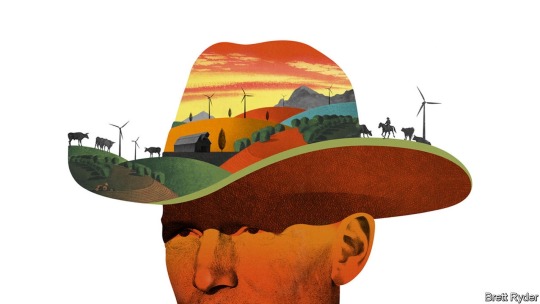
For more than 140 years John Davis’s family has owned the Pecan Spring Ranch on the prairie lands of West Texas. He has a photo of his great-great-grandmother, known as “the sheep queen of Texas”, sitting in a horse-drawn carriage beneath a tree that still stands in front of the hay barn. It’s a tough business to maintain, even with a valuable herd of Wagyu beef cattle to raise. Yet when a renewable-energy developer offered Mr Davis a large payment to put wind turbines on his land, at first the staunch Republican—and former state congressman—turned it down.
His opposition was knee-jerk. “Clean energy has been branded a liberal technology. People literally say, ‘this is AOC coming into town,’” explains his son, Samuel, referring to Alexandria Ocasio-Cortez, the left-wing congresswoman whose name pops up with almost flattering frequency among conservative Texans. Eventually, though, economic sense prevailed. As the family points out, at an average return per acre, cattle generate $8, deer hunters $15—and wind hundreds of dollars. It assures the ranch’s future.
Now hosting seven turbines, the family embraces renewables as religious converts would. Samuel is a representative for the Texas Land and Liberty Coalition, which promotes wind and solar energy among ranchers. His parents have bought a filling station, ripped out the petrol pumps, and are converting it into an electric-vehicle charging station (with a farmers’ market on the side). Your columnist sat down with the clan last month over a breakfast of quiche and tomato-jalapeño jam, before bouncing across their ranch in an electric buggy. He learned lessons about clean energy that challenged his own philosophical assumptions.
The first is that you do not have to believe in climate change to support renewables. Quite the opposite. For a portion of conservative America, things like climate change and carbon taxes are still viewed as big-government malarkey. Even greenery is despised as a term co-opted by the left. “When someone says we are embracing green energy, it’s like shoving an ice pick through our ears,” says Matt Welch, head of Conservative Texans for Energy Innovation, another pro-renewables group. “We just say clean energy.”
This is not just Texan recalcitrance. Wind power is abundantly harvested in states run by Republican governments and over land owned by climate-sceptic ranchers. The message they prefer is a more free-market one: that wind and solar are increasingly competitive sources of energy, help reduce electricity costs, foster entrepreneurship, and are no less American than oil and gas.
It is a surprisingly effective mantra. You might think that California, which talks a good game about climate change and green energy, is on the forefront of renewables development. But Texas is far ahead. According to a study commissioned by Mr Welch’s organisation, in the second quarter of 2022 his home state had three times more wind, solar and battery storage under construction than California. The Energy Information Administration, a federal agency, predicts that this year the share of renewables in Texan power generation will for the first time exceed that of natural gas.
That helps explain the next lesson. For all the mockery of AOC, it is from their own Republican ranks that wind-energy ranchers face the most antagonism—especially from fossil-fuel producers who fear being undercut by renewables. Organisations like the Texas Public Policy Foundation (tppf), which lobbies on behalf of oil and gas, and the Texas Landowners Coalition, backed by right-wing beneficiaries of the fracking boom, are fighting tooth and nail to curb wind development. The tppf’s battle extends to proposed offshore wind farms as far away as New England.
Jason Isaac of the tppf says his organisation helped convince the Texas government to let a school-district tax credit lapse on December 31st that encouraged renewables investment in rural Texas. He argues that such fiscal support distorts the power market, though that stance ignores other incentives for oil and gas producers. He blames wind for the blackouts across Texas in 2021 caused by storm Uri, never mind that an official report concluded that “all types of generation technologies failed”, including natural gas and coal. Republicans accuse liberals of “cult-like decarbonisation”, yet their policies hurt some fellow conservatives.
The third lesson is pragmatism. Even though Republican lawmakers unanimously opposed President Joe Biden’s Inflation Reduction Act (ira), which provides hundreds of billions of dollars to curb America’s use of fossil fuels, red states like Texas plan to lap it up. The Davis family do not support the ira, but they hope its expanded federal tax credits will entice more wind and solar to rural Texas. The state also expects to attract big hydrogen and carbon-sequestration projects. Other Republican states like Alabama, Georgia, South Carolina and Tennessee are welcoming billions of dollars of clean-energy investments spurred by the ira. Even conservative businesses that lobby strongly for fossil fuels hope to benefit from the energy transition. For example, Koch Industries, an energy conglomerate, supported a big investment by Freyr, a Norwegian firm, in a battery factory in Georgia that will benefit from the law.
Don’t Waste Your Breath
The upshot is that there are ways to promote clean energy that do not rely on convincing climate sceptics that they are bonkers. A better sales pitch may be to play up the cost advantages of renewables rather than the climate benefits, emphasise their contribution to cutting air pollution rather than carbon emissions, and acknowledge that, owing to intermittency factors, natural gas may have a role to play in power generation for years to come. As Michael Webber, a professor of energy at the University of Texas, puts it, “It’s not unusual for Texas to do the right thing for all the wrong reasons.” In the end, everyone’s aim is a better future. As the elder Mr Davis says, many ranchers lucky enough to have oil under their land have benefited for generations. “We struck wind.” ■
— This article appeared in the Business section of the print edition under the headline "Not Green But Clean"
0 notes
Quote
Taking the warlord's skull as a trophy is acceptable. Not as a hand puppet.
Martin to Folgrim
45 notes
·
View notes
Quote
Pursue means 'chase after' not just make called shots to their knees!
X, to Axl
#source: mr welch's list#submission#submitted by snufficator#x#axl#mmx#megamanx#axl mmx#x mmx#incorrect mmx quotes#quote#quote with an actual source
39 notes
·
View notes
Text
I was talking to some friends the other day about Sandy Welch's screenplays (North and South 2004, Jane Eyre 2006, Emma 2009) and the ways in which she transforms the source material in such a way that her screenplay is reminiscent of the impressions of some readers rather than the story itself. If adaptators were like art copists, while others would sit in front of the painting to reproduce it, Welch would study it for a long time and then sit outside to reproduce by memory; she produces a painting that is recognizable as referencing the other painting, but that cannot be really called a copy.
I'm not saying this is bad; in fact, I think she has an extraordinary talent to replace book dialogue with more modern sounding language while still not making it feel completely out of place (as adaptations like Jane Eyre 1997 show, this is not an easy skill to master). She also takes adaptational risks meant to A) give context and texture with things of the period that were familiar to the reader of the time but may be lost on us or B) introduce elements of other stories/tropes the audience may be more familiar with.
I used to say a lot that Welch's screenplays take risks that sometimes succeed greatly and sometimes crash horribly, no in between, but was never able to put my finger in the mechanics of it, but I think the distinction above is one that I think is illuminating, specially when it comes to looking at her North and South and Jane Eyre.
Emma (2009) is the one, I think, where less of A) and B) appear. If anything, somewhat anachronistic elements are added, like the preface montage that has a more Dickensian bent. Most of the adaptational elements on this script are there to highly themes and internal connections (Emma and Miss Bates are linked for the audience in the scene where the Bates are the last to leave the Weston's wedding breakfast; Emma's loneliness is showcased in the scene afterwards where she remembers a childhood scene with her sister and miss Taylor, and Mr. Knightley's arrival pulls her back into society).
In Jane Eyre (2006) we can see a good chunk of A at play, but not so much of B. Rochester is given enthomology interests (pointing to the boom of natural sciences in the 19th century), we are shown the fascination with the exotic and "oriental" in Jane's daydreams, we are exposed to the theories about genetics, inheritance, and phrenology that will later on end up in the boom of eugenics... when it comes to B, though, there's little more than a closing of the age gap between Jane and Rochester (he's characterized as a younger man, while Jane is played in a more world-wise fashion, with the presence of a woman in her mid 20s), and an attempt to link A and B through the twins argument (which, IMO, backfires, badly). So, all in all, the story stands on its own, with a few changes to neutralize some of the less likable bits to a contemporary audience (Jane's naivety, Rochester's wickedness at some points, the religious and moralizing tone of much of the story and in particular of Jane and Helen's relationship, the reduction of the impression of age gap between Jane and Rochester, etc).
And now we come to North and South (2004). Now, as those who follow me most likely know already, I'm ambivalent about this series. There's much to love in it and much that I just... no. And I think this is due to the following reasons: the source material in this case has a very different quality than the other two; A sometimes gets in the way of things that are important to the building of the overall story; B is used a lot and obscures much of what makes the original story great. Let me explain:
North and South, like most of Gaskell's best writing, is very little about plot and a lot about the inner lives of the characters and the ways in which they go through life and deal with tragedy. This is, understandably, something quite difficult to portray. Emma and Jane Eyre are, even if the bildungsroman part in them is important, far more plot heavy stories. If you want an Austen comparison, adapting North and South is a lot like adapting Mansfield Park (in fact, this post was inspired by a conversation about what a Sandy Welch script for Mansfield Park would look like). One bit of trivia that further supports this is that the title North and South came out as a request/demand from Dickens, while Gaskell's chosen title for the story was Margaret Hale.
North and South 2004, like Jane Eyre 2006, presents contextual elements, the most impressive of them, the use of actual 19th century cotton mill machinery in a mill environment. I don't really know if it is something that is kept operational in a museum context, but even so, when you stop and think all that was needed in order to get footage of working 19th century machinery AND of people operating it... wow. And it makes sense that they would show this off. But then we have Margaret get into the mill to see it, which breaks one important element of the narrative: all the knowledge Margaret has of the mill situation and the hands/masters conflict is second hand. She listens to Thornton and to Higgins and to Bessy, and like the reader, she needs to make up her mind without having any first hand access to the facts. That narrative tension of the book is lost.
The second big A element of this series is the London exposition. Here we are given a sense not only of the enterprenurial spirit of the 19th Century and the wonders of its inventions, but also of the extent of the power of the British empire at its peak. Which is great except for the fact that it cuts the tension of Margaret not being able to leave Milton. And this is very important because it helps us feel empathy for Margaret, focus on her sense of being trapped, stuck, and then be surprised when, in leaving, we realize the friends she gained, the growth she underwent, and the subtler freedom she had there, once we are brought back to the mental constriction of aunt Shaw's London.
Because N&S sits in this crossroads of psychological novel and social novel, where the marriage plot is structural but not necessarily central, it is here where Welch appeals the heaviest to B: North and South is then filtered and rearranged through evocation of Pride and Prejudice, Beauty and the Beast, and Hades and Persephone. This in turn predisposes the audience to seek for these things in the novel itself, obscuring the things that make it great. If N&S is just a Pride and Prejudice redux with some B&tB and H/P thrown in, then it is, indeed, a pretty mediocre version of it. But it is not!
Helstone is not paradise or eternal spring: there people live very hard lives, with little comforts, stagnation, and lack of education. Yes, it still has the beauties of rural life, but it shares in its drawbacks as well. The same way, Milton is not hell. There's the risk and the desperation and the smoke and the rattle of machines, but there's also change and comforts and opportunities to cultivate the mind (while in the series the ateneum is just an excuse to say how boring Mr. Hale is and that it is all an excuse to have union meetings, in the novel people do actually go there to learn things). Gaskell is not a manichean writer, in the vein of Dickens.
Thornton is not the lonely lord of a world of grief and oblivion: he's a bulldog like no nonsense businessman with a family to take care of, a practical man with an iron will and very fixed ideas about how the world works and should work. It is only at this point in his life that he finally has leisure to cultivate his mind and "have feelings" and that's why he falls so hard for Margaret. And what he likes about Margaret isn't really some sense of freshness or vitality and whatnot, but that she has a regal, commanding air (yes, Thornton is a "please, step on me, madam" man) to her. Likewise, Margaret is not the sunny princess of a sunny realm: she's an observing, serious girl with a fiery temper, very pale and dark haired.
Compare the meeting of these two characters between novel and book. In the novel they meet at a pretty neutral point. Margaret is kind of cold because she's tired and wants to take a nap and WHEN IS THIS MAN LEAVING SO I CAN REST IN PEACE. Whereas Thornton reads this as haugtiness and yet cannot help but be fascinated by her and cannot really leave because of it. It's human, it's silly, and simple and endearing and frustrating all at the same time. In the series they meet at the factory, where Margaret dramatically shows up just in time to see him beat a man into a pulp. Very beauty and the beast, but very little in the end about what makes these two characters suited to each other and what kind of growth needs to happen for them to end up together.
The biggest sign of this problem is Margaret's characterization in the series; she's not a very developed character, and her intentions and motivations seem capricious or at least very hard to grasp... which is something that shouldn't happen in a story about her. Important milestones of her character, like her visit to Helstone where she needs to finally let go of the idilic and naive perspective of her childhood, and the contrast with Mr. Bell's grief for the loss of the world of his active adulthood, are obscured by dramatic points: in this case, the out-of-nowhere coy marriage proposal of Mr. Bell (seriously, series, what tha).
So... is the series bad? no, of course not. It's a beautifully shot, gorgeously scored, well acted, well paced, carefully set in period piece and it deserves the love and praise it gets. What I'm trying to say is that judgements about the novel based on the tropes of the series, in which the final ruling is "the series is better" precisely because these tropes are tangible in it completely misses the point of what the novel is about and the fact that it was never intended to be those tropes to begin with, so it cannot fail at portraying them. You may be more or less interested in what the novel is trying to do, and that's okay, but it has a merit and a value of its own that deserves highlighting and explanation.
Thank you so much if you made it this far XD
#Elizabeth Gaskell#North and South#North and South 2004#Emma 2009#Jane Eyre 2006#Sandy Welch#Jane Austen
149 notes
·
View notes
Text
ROSE to DAVE, about his time powers: You should refrain from appearing with Hitler in any history books. Especially if you’re chasing him with a wheat thresher.
#submission#Source: Mr Welch#i will absolutely show up in the history books if i am chasing him with a wheat thresher#homestuck#incorrect homestuck quotes#incorrect quotes#mod dave#rose lalonde#dave strider
56 notes
·
View notes
Text
The Mosley Review: Fear Street Part Three: 1666
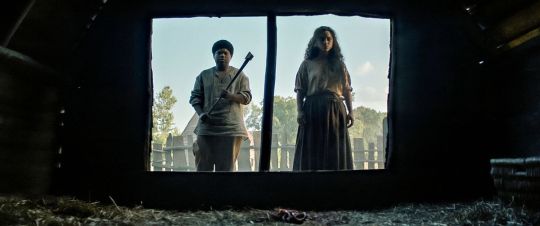
The third film in a trilogy is always the hardest one to do. You start off so strong and the pressure is so immense on third film to deliver the same quality and satisfying ending. Many have succeeded and alot have failed, but this film did the former. I cannot stress how much fun it has been to follow this amazing, thrilling and suspenseful trilogy to its end. I have been surprised by the amount of care and consistent quality of storytelling across the board. I loved how we get the origin story behind the curse on the Shadyside and the source of all the affliction. Puritan stories and how quick the title "Witch" is always easy to show the atrocities committed by thy neighbor, but I liked how the pacing kept it moving and didn't linger on that aspect. The story may have shrunk in scale, but that was a plus. The story can focus on the characters and the flow of the story. This chapter did that the best and I loved every second of it. I simply cannot get over how invested I became in Sarah Fier's story and how heartbreaking it was. That was truly a testament to the excellent from a brilliant cast.
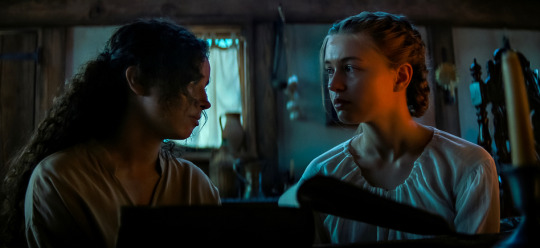
The cast across all three films have been amazing and they all return in an American Horror Story style as they all do double duty. Kiana Madeira delivered a knockout performance in this film as both Sarah Fier and Deena. Per the story, she experiences Sarah Fier's life through a supernatural connection and she was outstanding. I connected with her instantly and how she fought like hell to prove her innocence. Kiana delivers not only an emotional performance, but a strong physical one as well and that was impressive. Elizabeth Scopel plays the "real" Sarah and we only get flashes of her. I understood the connection that was made, but I would've liked to have seen Elizabeth's take on the character. Olivia Scott Welch returns and as Hannah Miller she was excellent. I felt that the loving bond between her and Sarah was more powerful and pure. Something about the past makes everything more special. Benjamin Flores Jr. was good as Henry and just as solid as Josh. Doesn't matter the era, those two are great together as brother and sister. Jordana Spiro was great as The Widow and Mrs. Lane. She always has a presence in each film and I feel like she's a good luck charm in the way of Bruce Campbell, but more dramatic. It was great to see Mrs. Lane finally get closure. Gillian Jacobs returns as Ziggy and she was truly having alot of fun. I loved how she faced her trauma later in the film. McCabe Slye was great as Mad Thomas and I loved his determination. As Tommy Slater from the past film he embodied an unstoppable force, but here he embodied the town drunk and fool with an influence. Darrell Britt-Gibson was hilarious as Martin and I'm glad he got real time to shine. Ashley Zukerman was outstanding as Solomon Goode. He was so charismatic and heartwarming at times. As Nick Goode, this time he gets into the action and it was so satisfying to see. The cast across all three films have done an amazing job and I commend them for their work.
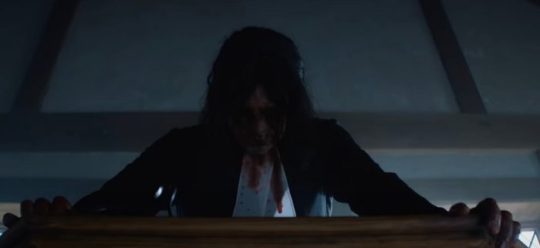
The score once was a standout and with composers Marco Beltrami, Anna Drubich and Marcus Trumpp, it was perfection. This was the most haunting, terrifying and heartbreaking score in the trilogy and I almost prefer it over Part Two. I just love the implementation of different sounds and its infections intensity. Srash’s fate is by far my favorite piece. The cinematography has also been a highlight across all three films, but lighting was key in this film. It was expertly done and visually stunning in both 1666 and 1994. Director Leigh Janiak has done the near impossible and adapted R.L. Stine's popular novels into this rousing success of a horror trilogy. This trilogy is some of the best content that Netflix has ever produced. This was a fun, intense, heartfelt and outstanding trilogy that should not be missed and it is now up there with the greatest of all time. For horror fans, this will satisfy the lust for teen blood to be spilt on the screen in many ways and you owe it to yourselves to see this masterpiece of a trilogy. All three Netflix original films are now streaming. Let me know what you thought of the film or my review in the comments below. Thanks for reading!
#fear street part three: 1666#kiana madeira#olivia scott welch#benjamin flores jr.#Ashley Zukerman#sadie sink#gillian jacobs#jordana spiro#darrell britt-gibson#shadyside#sunnyvale#sarah fier#elizabeth scopel#netflix#netflix original
37 notes
·
View notes
Photo



:: No-More-Mr-NiceGuy: Amanda Archer's 1964 Ford XM Falcon coupe
By Carly Dale | Photos: Rick Welch - source: www.whichcar.com.au ::
31 notes
·
View notes
Photo
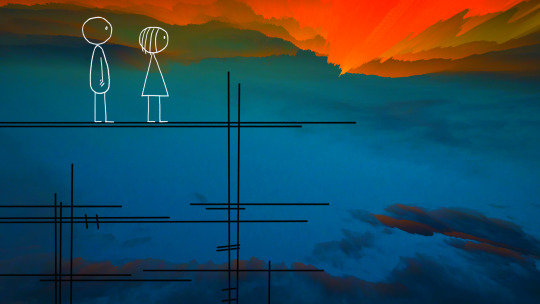
Beautiful Day: The Don Hertzfeldt Q&A.
In which the singular creator of It’s Such a Beautiful Day and the World of Tomorrow trilogy answers 57 questions put to him by the Letterboxd community, about death, gills, snacks, back flips, the best time of day to watch a movie, and the sick pleasure of emotionally destroying people.
Since his first animated outings in the 1990s, filmmaker Don Hertzfeldt has had a way of staring deeply into humanity’s soul via a humble stick figure, and his skill at blending existential questions with situational humor breeds intense reactions. To browse Letterboxd reviews of Hertzfeldt’s animated works is to meet film lovers at a rare, collective gathering point: heaping great piles of love for films that do “the exact opposite of helping with depression”.
There’s something optimistically anti-feel-good in Hertzfeldt’s works; a bleak view of the future, and a frank appreciation of death’s inevitability, that makes viewers urgently want to fix the way they’re living right now. “I’ve built a lot of my life philosophy on the messages of this film,” writes Misty, of his acclaimed It’s Such a Beautiful Day. “It has kicked my ass completely,” writes Dirk of the first, Oscar-nominated World of Tomorrow instalment, “making me angry at myself for letting trivial stuff take over things I love and making me happy I have so very, very much in my life to enjoy and be grateful for.”
The filmmaker’s magic lies as much in the process as the content: “Hertzfeldt is able to make every moment count,” writes Artpig, of the second WoT instalment, The Burden of Other People’s Thoughts, “every line of dialogue, every moment of silence, every note of music, every line of animation.” The World of Tomorrow films, says animation expert Toussaint Egan in our Letterboxd Show animation episode, are “some of the best science fiction films, period”.
And his timing. Oh, his timing. Just as the northern hemisphere days were turning cold, and the drawn-out misery of the pandemic was really taking hold all over again, Hertzfeldt tweeted:
WORLD OF TOMORROW EPISODE THREE
everywhere
october 9
5pm est
🚀
— don hertzfeldt (@donhertzfeldt)
October 8, 2020
And like that, World of Tomorrow Three: The Absent Destinations of David Prime was ours, an overnight gift to the quarantined and bereaved-weary, on Vimeo for all to rent or own. The gifts, they keep coming: a master list of movies that have their fingerprints on the World of Tomorrow universe, and now, in recognition of our community’s love for his films—and in his signature lower-case—the answers to questions asked in an exclusive Letterboxd Q&A.
To make things easier for Don, we grouped similar questions (and have noted which members asked what). Read on for more than you ever thought you might get to know about Hertzfeldt’s process, brain, heart and influences.
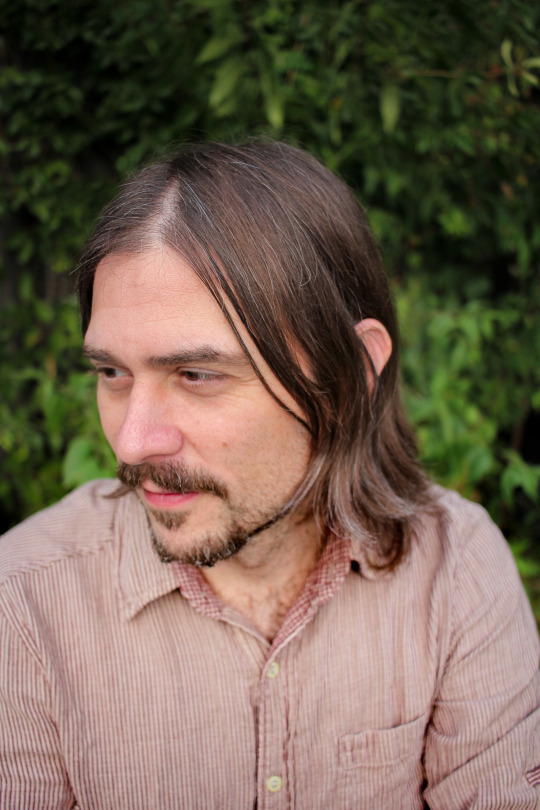
Filmmaker Don Hertzfeldt.
From “holograms that yell at you!” to the stunning colors, textures and folds of the blue mountains, to attributes David progressively deletes to make room for memories, would you please give us an insight into World of Tomorrow Three’s world-building process? —Letterboxd
in the grand scheme of the series, episodes one and two still felt like baby steps to me. episode three was my first chance to really start blowing things up and exploring this universe. when i’m writing, i don’t want to worry about going over the top or think about structure or meaning or really much of anything yet. writing is playtime, it should be fun and messy. i want to go over the top. there is no top. i don’t want to start thinking too much until i’m rewriting and sorting through it all. thinking too much too soon can get in the way, like being too aware of when you’re trying to fall asleep. when you write a diary entry or a text to a friend, there’s no self-consciousness or creative blocks, you just write. it’s casual and fluid and automatic. but if you’re asked to write a term paper or a screenplay, suddenly all those lights turn off. it can be paralyzing. it’s hard to get to that place of truly not caring what anyone thinks and approach all forms of writing just as freely as writing those immediate thoughts in your diary. but that’s what i try to do.
When you start writing a new piece, do you usually start with a plot idea, a thematic idea, one uniform philosophical notion, or a little bit of each? —Kodiak J. Sanders, Trenz, Mr. Tables
i don’t think i ever write in a straight line. i’ll jot down a hundred stray ideas over time, and one day i’ll sit down and see what connections might be made out of them. i really want this scene to be in the movie, so how do i get there? this is a good line, how can i get a character to say it? so the actual story usually only starts to reveal itself when i sit down to logic all these bits and pieces out. hey, in order to connect this strange idea to that strange idea, suddenly there is a very interesting third scene.
I’m astounded by how much the animation and the visuals improve with each instalment of World of Tomorrow. What have you done differently for each one? —Aske Lund, Cringetacular
the characters needed to physically perform a lot more in episodes two and three so there were more demands put on the animation. when emily 4 dances or david staggers up a mountain, those sorts of scenes were animated in “ones”, which means doing 24 drawings per second versus my usual twelve. it’s still all 2D hand animation, just more of a classic disney approach that gives the movement a smoother look and a little more room for nuance. and obviously it takes a lot more work. but i hesitate to call such things improvements because i’m not sure i like the idea of different techniques being thought of as good or bad. it’s just another way of doing things. it really depends, sometimes super limited animation can be more effective.
Likewise, Part Three’s sound design is incredible. What conditions did you create it in, and what are all those sounds, and how do you have such an incredible command of the cut-to-silence trick?! —Letterboxd
thanks, the sound design is always my favorite thing to do. other than julia’s lines, it’s easy to forget that all the animation starts with dead silence. obviously there’s no sound coming from a live-action set. so adding sound and music to everything, usually pretty late in production, is when all the stuff i’ve been working on suddenly starts to feel like an actual movie. this is not a future that works very well—particularly david’s, which predates everything else we’ve seen so far by a century or two—so you’re hearing a lot of creaky old hard drives booting up, electric distortions, and bent circuits from broken toys.
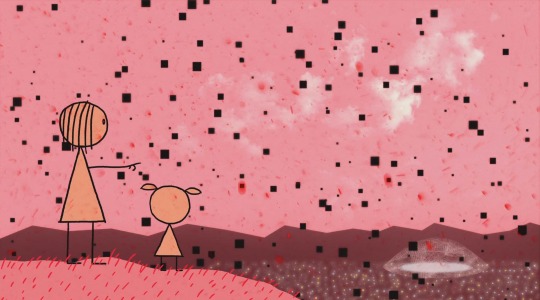
Emily and Emily Prime in a still from ‘World of Tomorrow’ (2015).
World of Tomorrow used to fill me with existential dread, but now with the current state of the world it’s become more and more comforting in a strange way. Do you feel that at all as you make new episodes? —mariano gg
i wish that were possible but when i’m making something i’m usually so close to it i’m unable to see anything but all the things i need to fix.
Can you talk a little bit about sourcing the photo-realistic images for the backgrounds in Part Three? —Jack Moulton
most of the environments were 2D images i built in photoshop, usually starting from close-up photos of different textures (like sandstone), all sort of reshaped and puzzle-pieced into something new. an easy to see example was david’s cockpit, which was cobbled together from all sorts of different old aircraft engine and machine parts. the trick in building and lighting these locations was always figuring out where the line was drawn in making these places realistic, but not too realistic for minimal characters to inhabit. i kept landing on a sort of painterly looking middle ground.
If the cloning process in World of Tomorrow existed right now, would you go through that process and create clones of yourself to prolong your life? —tim
probably not, that process doesn’t seem to work so well.
If you were put into the world you’ve created, would you buy gills? —Lauren Torres
i tend to avoid putting my head under because i almost always get water in my ears so i guess i wouldn’t need them. gills also seem like they’d be a real nuisance to keep clean.
What does love mean, and why do your characters go through so much effort to find it? —Andrew Michalko
oh man.
In this year of years, what do you hope people will understand about death and its inevitability (or is it all there on the screen, and if so, that’s okay too)? —Letterboxd
understanding death and its inevitability is maybe the most valuable thing a person can do for themselves.
Was the absence of Emily Prime in Part Three a practical decision [Don’s then-four-year-old niece Winona provided Emily’s voice] or an intentional departure from the first two films? —Michael
it was both. i couldn’t find a way to fit her in naturally and i also felt like the series needed to start growing in other directions and not rest on the past. episode two had also been really difficult to write, it was so reliant on winona’s recordings, and it felt like the dam was really broken when i was finally able to write without any restrictions this time.
In a series like World of Tomorrow, where you headed in a direction that is a lot more plot-driven than your previous work, how far in advance do you plan? Did you always know this was in David’s past, or are these stories told one at a time? —Ryan Welch, Kodiak J. Sanders, julius, Alex Leon
i could tell early on that this wasn’t a story like it’s such a beautiful day with a clear beginning, middle and end, but a much wilder thing that could continue to grow. the openness of it is still what makes it so interesting to me. i have all sorts of notes for the next episodes but if i already knew what would happen in episode nine i think that would take a lot of the air out of the tires and i’d start to feel like i was just connecting the boring dots. while writing, i’ve also had to be aware that there someday might be an episode nine so i can’t go wrecking the timelines before i get there.
What were the rocks and the gas pump that Emily fell in love with meant to represent? —Ekaneff
she was learning how to love, and like all of us, in her youth she gravitated to a bunch of individuals that were wrong for her.
Aside from the ability to release more frequently, is there something about the episodic structure that you prefer/appreciate, as opposed to creating one larger feature-length film? —SiddFinch1
there’s just more freedom. the traditional running time of a feature film, 90 to 120 minutes, is a totally arbitrary number.
Have you ever considered writing a World of Tomorrow book or graphic novel? —Jay Smith
the earliest ideas for world of tomorrow were sloshing around in a graphic novel called the end of the world that came out in 2013. but i don’t have any talent or much confidence in making another book like that. it’s a different world. when i look at someone like chris ware and then look at something like the end of the world, it’s like, “wow, baby made a mess”.
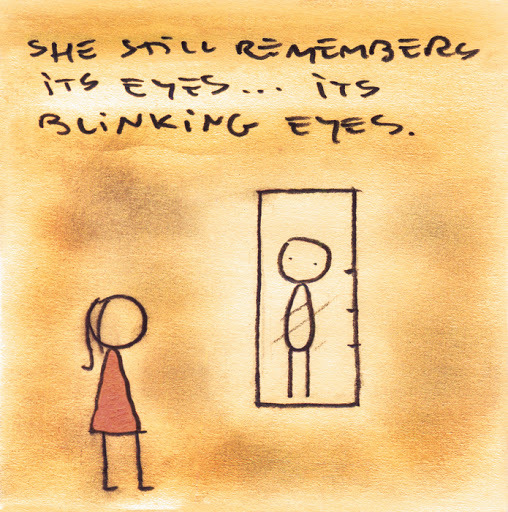
A page from Don Hertzfeldt’s graphic novel, ‘The End of the World’ (2013).
What attracted you to the unique style [of minimalist stick figures]? Is there a sense of intimacy that you feel you can achieve with this simplicity? —Evan Whitford
when i was little, before i wanted to make movies i wanted to be a newspaper cartoonist. i think my drawings today might have more in common with newspaper comics than the sort of characters you usually see in animation. comic-strip panels were always composed in a very reserved way because they were generally intended to be skimmed. you needed to be able to read the strip in five seconds so you could be off to read the sports pages and obituaries. the comics pages were also under constant size and space restrictions. so they were minimal by design and the artists reduced their characters to only their most essential parts. there was no room for fussing. charles schulz said “i only draw what’s necessary”. and that’s actually incredibly hard to do. you’re accomplishing so much more with so much less.
i’ve also found that if there’s a scene that’s not playing right and bothering me, most of the time it’s because my composition was too cluttered. i almost always find myself removing things from the frame and trying to pare it down to only what’s necessary. very rarely do i ever think ‘i need to add more stuff in here’. because this shot is only five seconds long and i want you to be looking over here when this moment happens and this character says something, and if you’re distracted by this other flickering junk i put in the corner it’s going to throw everything off.
Animation-aside, which creative medium do you resonate with the most? —Bronkdan
music.
How much did you pull from real-life experiences to make It’s Such A Beautiful Day, if any? What research did you conduct into memory? —Gunnar Sizemore, David Sigura, Micah Smith
whenever i got a little stuck writing it’s such a beautiful day, i’d go back and reread my journal and pull more things out of it. dreams, conversations, small scenes. reading the journal now, it seems like i stole something from it every few pages. i also heavily researched neurological problems. it’s never said in the movie what exactly’s going on with bill, but i needed there to be a real diagnosis to base the medical writing on. so all the things he’s going through are real treatments or symptoms based on an actual condition. i didn’t want to ever come out and say, “he’s got terminal brain clouds”, or whatever in the movie, because then it becomes a “brain-cloud movie”, and that’s too easy for the audience to compartmentalize and distance themselves from… “brain clouds are so rare, that will never happen to me”. but not being told exactly what’s wrong with bill might help make the story more relatable and universal.
In what ways have you kept your mind fresh creatively? How do you keep yourself from slipping into complacency? —Watchmoviez, Drew’s reviews
most creative blocks or stagnation come from anxiety, second-guessing and doubt. over the years i’ve learned to just sort of calm down and trust myself more. it’s like the old aesop fable: when you stop thrashing around in the water, the water becomes clearer and you can see more. if a scene isn’t working right, i can more easily chill out about it these days and trust that i’ll eventually figure it out—because i’ve figured these sorts of things out a hundred times before and i know by now that i’m not the sort of person who’s just going to allow a scene that isn’t working to remain in the movie. there’s a little more panic about that sort of thing when you’re young: “oh no, the movie sucks right now, will it always suck?!” i’ve reached the point where i know that i will not let it suck. and that sort of thinking allows all the movie gears to turn more easily.
Do you have a specific thematic, emotional or other miscellaneous motive in mind when including classical music pieces? —James Y. Lee
when i’m listening to music and suddenly the right piece arrives, it’s usually blindingly obvious to me: there’s just no doubt this needs to be in the movie somehow. it’s like the idea has always existed and i’ve just finally uncovered it. it’s the same with writing. when the right thing floats along, it is striking and obvious and into the pile of notes it goes.
How much of your animation style lends itself to experimentation, such as discovering new tricks and pretty shots, that is then discarded if you learn it doesn’t work as intended? —Adam, Jacob
i think i’m always experimenting. i figure if it doesn’t work, at least i’ve learned something.
What is the strangest compliment or critique you’ve gotten personally or of your work? —Elliot Taylor
i’ve always remembered this one. i am so proud of you came out a couple years after everything will be ok. it was a continuation of that story, so it was basically the first time i had ever made a sequel. and everything will be ok had done really well when it came out. it won sundance and got all these great reviews. so i am so proud of you comes out and i remember reading this review that says, “everything will be ok was probably my favorite animated short of all time. it honestly changed my life. it was funny, sad, beautiful and just so wonderful. everything will be ok, boy did i love it. incredible. two thumbs up. truly, best thing ever. wow. so, unfortunately, its sequel, i am so proud of you, just feels like more of the same.”
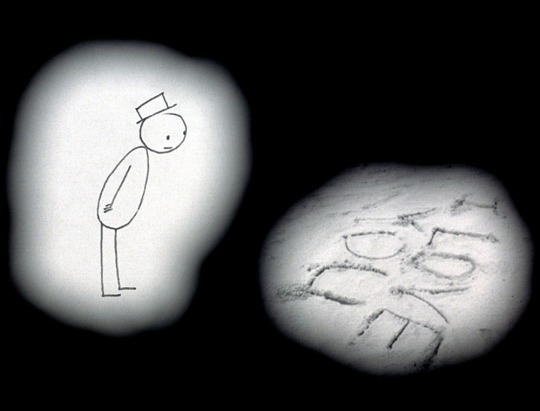
A still image from ‘It’s Such a Beautiful Day’ (2012).
Are there any pieces of fiction that have influenced your work that we probably wouldn’t think of? —Gyani Wasp, Mikolaj Perzyna, Aaron McMillan, Harrison, Axel, Cringetacular, The25centman, Hunter Guidry
one thing that pops to mind is the phantom tollbooth. my favorite children’s books were the ones with all the fun metaphors and clever wordplay. when i was plotting out episode two i wanted to lean into that, where visiting different sections of emily’s brain would be like milo visiting the land of math, the land of letters, the land of sound, with different looks and logic to it. so we had the bog of realism, glimmers of hope, broken memories, the logic center, and all the stuff in triangle land and square land. i guess that’s a lot but i wish there had been a bit more.
How did your friends and family respond to the “my anus is bleeding” part of Rejected? —Alex Tatterson
they were pretty used to me by then.
Do you know of the work of David Firth, the internet animator? His work is also surreal and has dark humor, but more sinister than whimsical. Would you ever consider making an animation in the realm of horror in future? —KEVIИ HДWKIИS
i’m afraid i don’t know him. i’d love to make a horror movie. from a certain point of view though maybe it could be argued that most everything i’ve made is a sort of horror movie?
My first tattoo is of Billy from Billy’s Balloon hanging from his ankle and it was the best decision I’ve ever made. How do you feel about people having your work tattooed and do you have any ink from other creatives that have meant something to you? —Elias
it really fucking enrages me when people get my stuff tattooed on them. no just kidding. mostly i feel embarrassed but i’m glad you haven’t changed your mind about it yet. sometimes i wonder how many people have.
Have you ever thought about directing live action? —Abeer, Noah Thompson
yes.
Is there an update on your feature film Antarctica? —Rylan California
it’s one of many things swirling around.
Will you do a remake of Robocop and why not next year? —Simon
no, because robocop is already sort of perfect.
Do you ever see yourself directing a large studio film? Or working with a large team to make something with a higher budget, maybe through a crowd-funded project? Or do you just strongly prefer working on your own? —Vteyshev, Monotone Duck
sure. i’ve never preferred working on my own at all. it was usually just the only way to ever get anything made. i haven’t had the funding to pay a big crew, or really much of a crew at all. there’s the old saying: you can make something good, you can make it fast, and you can make it cheap, but you can only pick two. if you make it good and fast it won’t be cheap, if you make it cheap and fast it won’t be good, etc. so my only route in hoping to make something good and cheap has been to totally forget about making it fast.
What did you find digital animation added or took away from your work, and what did those changes do for your storytelling? Will you continue using the digital medium when/if you decide to move on from the World of Tomorrow project? —Alec Lai, Slipkornbizkit, Aldo
digital just sped everything up. it’s still one person drawing everything, so we need to remember that speed is relative here, but i felt like i went from riding a bicycle to driving a car. there are many pleasant, wonderful things about riding a bicycle but you’re not going to get anywhere very quickly. and i’m not in my 20s anymore, in fact my 20s and 30s were mostly entirely devoured by making movies in what was maybe the slowest way possible. so these days i am appreciating the speed of digital.
If you could have a conversation with any filmmaker, dead or alive, who would it be and why? —ToBeHonest, Cringetacular
if i could resurrect one of my heroes from the dead i think i would feel terrible wasting his time forcing him to have a conversation with me. he might also just sit there, covered with graveyard dirt, screaming in horror.
What is the best time of day to watch a movie? —Sammy
night. i always feel a little nuts coming out of a movie and the sun is still up.
What’s your all-time favorite science-fiction film, and why? —Letterboxd
2001. because come on.
What is your favorite of Julia Potts’ films, and why? —Letterboxd
i like the one with the severed foot.
Are there any animated films that you felt had a profound impact on you as a child? —Sprizzle
probably fantasia. and ray harryhausen stuff. whenever there was a sunday-afternoon movie on TV, my brother and i learned that if in the opening titles there was a credit for “special effects” we should keep watching because we might eventually see something cool.
Which one of your movies is your personal favorite? —Jakob Böwer, RodrigoJerez
i don’t know. sometimes it’s the newest one because it’s usually the one with the most experience behind it and therefore feels like it has the fewest mistakes. but then over time i realize they’re all riddled with mistakes. of the it’s such a beautiful day pieces, i think my favorite has always been i am so proud of you. and then i’ll see reviews that say “clearly the second chapter is the weakest one”, and i’ll think, man you guys don’t know what you’re talking about.
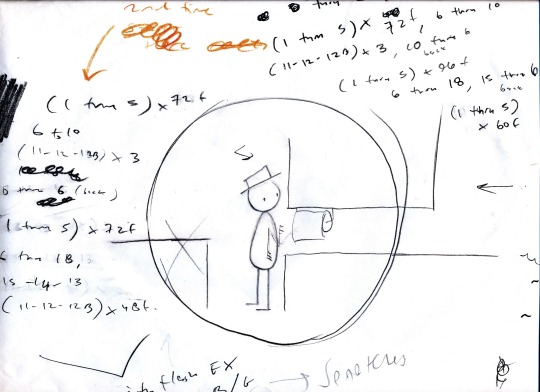
One of Don’s layout sketches for ‘I Am So Proud of You’ (2008).
What’s your favorite Pixar film? —Jordan
inside out.
What film would you want to be the last one you watch before you die? —Gavin
honestly if i’m in the process of dying i hope i won’t be watching movies at all.
Do you have faith in humanity? —Connor Kriechbaum
not often.
What is something that worries you about where humankind is headed? —Felix_Bouchard
social media.
What is the most valuable thing you have ever lost? How often do you think about it? —Siminup
well now i’m getting sad.
Can you do a back flip, mister Don? —Doug
maybe with the help of a catapult.
What is your take on the after life? What do you think happens to us when we die? —Luisdecoss
i guess that it’s probably a lot like our memory of what the year 1823 was like.
Do you want anything from McDonald’s? —Andrew Rhyne
only if i’m in an airport and desperate.
What’s your favorite meal or snack? —Pfitzerone, Evan
lately in quarantine i’ve been discovering this particular breakfast burrito.
How’s your quarantine life, Don? —Ivan Arcena
it’s okay thanks. eating lots of breakfast burritos.
Hi! I can’t believe you’re going to read this. I am currently filled with an unparalleled amount of joy, wow. This is a long shot but here I go. I’m 17 and your (self-proclaimed) biggest fan. I’ve seen It's Such a Beautiful Day eight times now and every single time I pick up on more details. I’ve watched a few of your interviews and in the AFS one about Rejected you said that the louder you play a movie, the funnier it is. On my seventh watch of It’s Such a Beautiful Day I hooked my laptop up to three huge speakers and I must say—you were so, so right. I made a video essay about the movie. Lol, I’m not sure if this will get to you but Michael Jordan once said something about missing shots or not taking shots or maybe about tequila, I am unsure but I know it was important. Thanks MJ. Not you, Mr Jackson. I’m sorry Ms. Jackson…
I actually do have a question, sorry about the rambling. Every single time I watch the guy at the payphone flip his pencil and go “fantastic, fantastic” I cry. And I think what really does it for me is that “we’ll finally have our day”. Earlier in the movie, Bill’s co-worker talks about how all of time is happening at once. So what I constantly ask myself is if the guy at the payphone is simultaneously having his day and waiting for it. And I’m no longer speaking to that one specific example or even to the movie as a whole but I guess I’m wondering if the idea of all events happening at once comforts you?
In Slaughterhouse Five, Kurt Vonnegut writes: “The most important thing I learned on Tralfamadore was that when a person dies he only appears to die. He is still very much alive in the past, so it is very silly for people to cry at his funeral. All moments past, present and future, always have existed, always will exist.” When I read this I immediately thought about your movie. I think the idea of all of time happening at once makes all of life feel less important but more special. You know? Anyway, I suppose I’d just like to know what inspired the lines about time in the office scene. This isn’t much of a question, more an incoherent ramble but thank you so, so much for all you’ve done. I feel so incredibly inspired and so deeply moved by your work and I know that so many people in this comment section and around the world would agree. I can’t believe I’ve been given the opportunity to ask something. It really is such a beautiful day. :) —Eli Osei (co-signed by Vooder)
that old guy at the payphone was someone i saw at the laundromat once and he borrowed my pencil and the whole thing just played out like in the movie. i just thought it was such a perfect little scene that i’d just witnessed. anyway, the idea of time being a landscape and everything taking place “at once” just came straight out of a science magazine. i don’t know how, but apparently it’s been more or less proven to be true? we perceive time in one direction, but the past and the future are always all around us. think of it as though we’re driving our car through a landscape. even though the mountains we saw ten minutes ago are behind us now, it doesn’t mean those mountains have ceased to exist. they’ve only ceased to exist from our point of view. we’ve only just driven past them. the mountains, like your childhood, are still going on back there. anyway, i had never heard of that before and thought it needed to be in a movie.
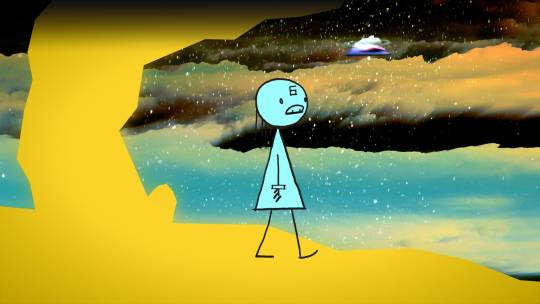
A still from ‘World of Tomorrow Episode Two: The Burden of Other People’s Thoughts’ (2017).
Are you a fan of Kurt Vonnegut by any chance? It may be coincidental, but I love how you both utilize science-fiction settings and concepts like being “unstuck from time/memory” to explore the human condition. I feel his writing and your animation are both capable of making me laugh wholeheartedly one minute and weeping genuine, sorrowful tears the next. —Vooder
i’m embarrassed to say i’ve never read him and i’m told on a regular basis that i should. that all started after i am so proud of you came out with those discussions about time being a landscape. but i almost only ever read non-fiction. it’s a long story. but now i’m almost afraid to ever read vonnegut after all these years of build-up.
Hey Don, this is really cool. I don’t have as much of a question, more of a comment. It’s Such A Beautiful Day has gotten me through a lot of hard times, being in middle school sucks, I think everyone knows that: and your movie has made life just a wee bit better for me. It also gave me the inspiration and motivation to finish my first feature! Thanks lots. Love from Indiana —Blood Mountain: Experimental Cinema <3
hey thank you. yeah middle school was pretty much the deepest pit of hell. there’s this old saying, “if you find yourself in hell, keep going”. and i’ve never understood that saying. “keep going”, because, i guess, you can always just go deeper into hell?
Hi! Has the vitreous humour in your eyes started to deteriorate and have you experienced floaters within your eyeballs? If not, that’s okay. Just remember it’s part of life, so don’t get scared when it happens! Just keep moving on! But if you do have them, follow-up question: Do you think it’s funny that the body of vitreous fluid that allows your sight to be clear is called the vitreous humour, and when it detaches it’s anything but humorous? I find that pretty humorous myself, in, like, an ironic way. —Clbert1
i actually blew a blood vessel in my eye a couple weeks ago and the whole thing turned bright blood red. it didn’t hurt or anything, i just walked into the room all disgusting and my girlfriend was like, “what the fuck?!” and then the next day i had further weird eye problems. i just went to the eye doctor yesterday. i think i will be fine but i was thinking, wouldn’t it be like the most heavy metal thing ever for my biography if i just suddenly went BLIND? “and then in 2020, HE WENT BLIND.”
Will Intro ever be released to the general public outside of theater screenings? —Melissa
okay yes you’ve talked me into it. on that note, i noticed that the poster of intro used on letterboxd is a weird fake and i’m not sure where it came from. someone just used a picture from rejected. if fake posters are to be made i would prefer it if they used a picture from raiders of the lost ark or something.
Do you have plans to combine the World of Tomorrow shorts into one feature-length film à la It’s Such a Beautiful Day? —David Sigura, Sam Stewart, An_Person
no, it’s going to be much longer than a feature-length.
Will we ever get a ‘Hertzfeldt 4K Collection’? Or at least a Blu-ray with It’s Such a Beautiful Day and all episodes of World of Tomorrow? —Teebin, HippityHoppity
there is actually already a blu-ray for it’s such a beautiful day. up next we’ll do some sort of world of tomorrow blu-ray of the first three episodes. but 4k is too many k’s. you don’t need that many k’s.
Would you ever consider comprising an OST album of all the songs you used and mixed from your films? —PhiloDemon
i don’t think so. i read that for many years cat stevens resisted releasing his original songs from harold and maude on any records because he thought they were more special if you could only ever hear them in the movie. i like that.
Do you get a sick kind of pleasure from emotionally destroying people with your movies? —MaxT26
yep.
What’s been your ongoing experience of the outpouring of joy and love of your work? —Henry
gratitude. how sad for me if, after all this work, nobody was watching at all.
Related content
Don’s invaluable Twitter thread about “old-school animation camera stuff”
A Few of the Fingerprints on the World of Tomorrow Universe: a list of influences curated for Letterboxd by Don Hertzfeldt
Modest Heroes: the Letterboxd Showdown for indie animation
The Drawn Cinema: Analena’s list of rough animation, pencil textures, watercolor effects, dynamic brushes and other poetic artistry.
Beloved Indie Animation: a list by Gui
Animated Sci-Fi and Fantasy: an extensive list by Stonefolk
‘World of Tomorrow Three: The Absent Destinations of David Prime’ is available now through Bitter Films on Vimeo.
#don hertfeldt#world of tomorrow#it's such a beautiful day#animation#hand-drawn#hand drawn animation#2d animation#animated film#animated short#emily prime#david prime#science fiction#sci fi animation#animated sci fi#letterboxd
15 notes
·
View notes
Quote
When surrendering, you are to hand the sword over HILT first.
Badrang to Martin
29 notes
·
View notes
Text
9x05: Dog Dean Afternoon
Welcome to our last hellatus recap. This is one of our themed episodes and it’s not too late to guess what that is. You’ll win bragging rights forever! Anyway, our show is back tomorrow!
Then:

Obligatory Teddy Bear shot of how AbsUrD this show can be. Note to Show: Don’t highlight the absurdity of this show when you’re about to air a so-so episode.
Now:
As a very dedicated taxidermist works on his Game of Thrones masterpieces, his very smart, very loyal German Shepherd, Colonel, alerts him to danger. They head through the halls of stuffed animals (but they’re all fake because who the fuck is stuffing these bears and shit? Also, a dog? Aren’t tigers endangered? WTF is all this?). Anyway, a man with a snake tongue attacks the taxidermist and Colonel sees it all.
At the bunker, Sam’s got a case.

Once at the Taxidermy shop, they find it covered in red paint, and a little paw print symbol. Sam takes a picture.
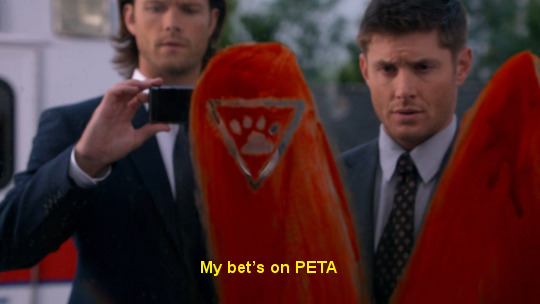
Agents and Michaels and Deville enter the crime scene. And by crime, I mean all the dead animals. WTF? Like. WTF? Let’s assume all these animals died of natural causes, so we can pretend the victim was “a good egg.” Sam heads off to tour the place and Dean stops to interview Mr. Stevens. As Dean learns about “entrails” and such, Sam looks over the merch.
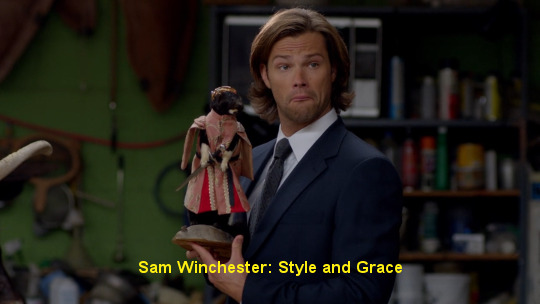
Poor Dean Bean continues to have frightening reminders about why he’s a germaphobe.
The boys are thinking witch, but decide to keep digging.

At their motel, Sam discovers the “wiccan symbol” is really an animal right’s group symbol. (LOL, I totally don’t remember this episode and I’m totally NOT changing my caption from above.)
Dean and Sam head to a vegan bakery where we learn that Dean knows the smell of Patchouli. Yeah, you might mask that with disdain for non-meat eaters, Dean, but we see you. They head to interrogate Olivia and Dylan, two founding members of S.N.A.R.T., the animal right’s group. They’re wearing sunglasses inside, so Dean thinks they’re douchebags. The brothers flash their badges. The couple sits down to talk about the victim. “You know how hunters are. They’re selfish dicks who define themselves by what they kill.”
They explain that someone attacked them with pepper spray and that’s why they look like douchebags.
Back at the motel, Sam further investigates the attack and the brothers surmise that they were attacked by venom.
At the local animal shelter, Brad gets a visit from Snake Man. Brad knows the guy and gets a $100 to let him walk into the kennel. The dude gathers ALL THE CATS and Brad wanders in to watch him EAT ONE. Yeah, we’re technically not on hate watch week anymore, BUT I STILL HATE THIS.
Brad doesn’t last long.
At the new crime scene, the brothers try to piece together the new information. Dean sees Colonel in a cage and ACCUSES HIM OF BEING A SUSPECT. GUH. Dean, just say you hate dogs and go home. Colonel doesn’t react to silver and Sam guesses they “can rule out killer.” Colonel starts barking.
How would you like to come home with me and live in a nice big bunker and go for car rides all the time and eat liver sausages and help solve mysteries?
Dean THE SMARTEST BEAN AROUND Winchester notices that Colonel is reacting to the local cop’s hat, so he tries it out. Bingo. Colonel was a witness to the crimes.
Sam thinks there’s a way to communicate with the dog to find out what he’s seen.
Kevin gets them a spell to talk with the dog. Dean agrees to drink the Mind Meld concoction because he doesn’t want Sam to take on more than healing from near death even if he doesn’t know if because he has an angel possessing him. Whew.

The spell doesn’t seem to work (But it DID, so can I like get said spell? I’d really love to talk with my cat on the regular, lolz, I’m not crazy.)
After eating lunch, Colonel sits up and asks for the channel to be changed. DUDE. It’s Foreigner. No one puts Foreigner in the corner. Dean’s on my side and has a nice argument with the dog while Sam watches confused.
Dean gets to the point of the situation and asks about the cowboy hat. The killer wears a hat. WBK. As he throws away his food wrapping, Sam wants to know about the cats. Dean retrieves it like a good boy. (but seriously, German Shepherds ARE NOT RETRIEVERS. Good luck getting them to return anything!)
Suddenly, there’s a noise outside and both Dean and Colonel head to the window to harass the mailman. Yep.
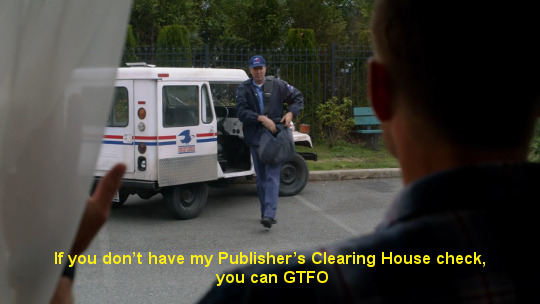
Back at the motel, Sam tells Dean that side effects of mind melding with an animal can include developing animal urges. Suddenly I’m reminded of Dean’s fascination with the dog familiar from season eight and feel horribly uncomfortable. Dean angrily opens a chocolate bar, only for the dog to warn him off of it. No chocolate? This is an outrage!
Outside, a pigeon poops on Baby. “Hey, dick move, pigeon!” The bird returns anger with insult. “Screw you, asshat!” Apparently all animals have a universal language just sprinkled with insults! Dean shouts at the pigeon with all the subtlety of a very large human-shaped dog.
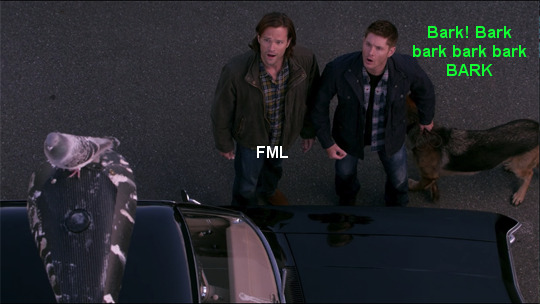
Sam manages to drag Dean into the car, but not before I make a diorama of this scene and place it on my Supernatural altar of Very Good Things.
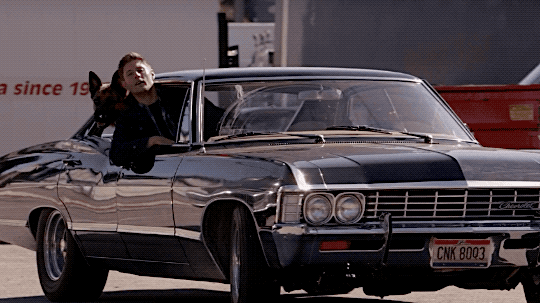
Dean and Sam argue over whether they should leave Colonel in the car. “You think we like that?” Dean asks, ROYALLY insulted. Hell, no. Colonel’s going in with them. In a moment where I curse my horrific prescience, Dean gives a lusty once-over to a nearby tied-up poodle. I…just…
Inside the shelter, Dean interrogates all the shelter animals. There’s only one dog who can give any good intel, and the dog only delivers in exchange for a belly rub. From Sam.
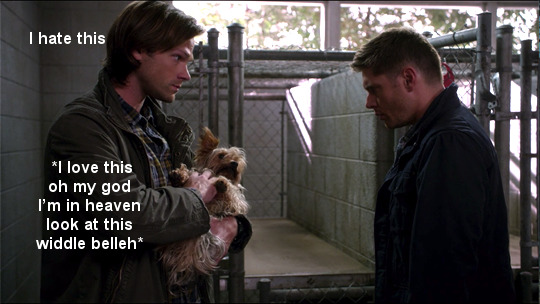
The dog gives them a tip: they’re looking for a cowboy hatted villain who works at a nearby restaurant. Dean lets all the animals free before they leave. “I didn’t peg you for a softy,” Colonel remarks. But WE all knew. Dean Bean <3
The Winchesters break into the restaurant that evening and discover a giant stash of prescription medications and…a cage of mice. The mice give Dean a tip: animal bits and pieces are stored neatly in the refrigerator. Sam finds a spell: with the right magic, ingesting a certain bit of animal helps the magician to temporarily gain that animal’s power. The guy’s mixing various animal parts to experiment on the effects and fun new powers he might develop.
Dean and Sam encounter a chef and waiter preparing a private dinner (featuring shark fin) and shoo them out under the guise of health inspector.
Chef Leo nibbled on a chameleon, which allows him to get the drop on Sam.
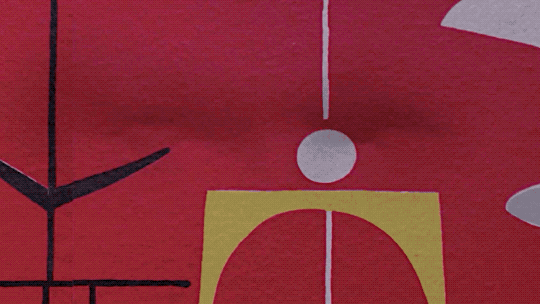
He swipes at Sam’s throat. Gadreel flashes to life and heals Sam’s terrible throat slash. Leo witnesses this miraculous healing and decides that Sam’s the ultimate snak - I mean, meal.
Leo sniffs out a dog, only to turn around and see…Dean. When the chef learns that Dog Dean and Angel Sam are brothers he is many levels of confused, but that doesn’t put him off his plans to chow down on Sam Fucking Winchester and his creamy angel filling. Dean, being a dog, immediately sniffs out some new information about Leo: he has cancer. Traditional treatments did nothing to help Leo, but his animal power worked. While his quest began sympathetically, murder is a side effect that Leo’s totally cool with as long as he can keep pushing the boundaries of man and beast. “Guess you eat enough predators, you start to become one.”
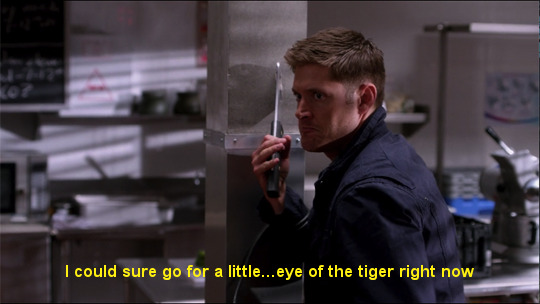
The chef pulls out a wolf heart so he can tear Dean - a mere dog - into little kibble sized bits. Dean breaks free just in time and leads Leo on a merry chase outside. He looks oddly triumphant for being cornered by Leo in an alley, and whistles sharply. A pack of the stray dogs come running and tear Leo to bits.
Dean races back to check on Sam and calls for Sam…or Zeke...to wake up. “Don’t make me lick your damn face,” he pleads dramatically. Sam snaps awake. Hooray! Happy ending!
We jump to the Colonel meeting the vegans from earlier. They wuv that cute widdle puppy wuppy! Dean regrets that they can’t take Colonel along with them but it’s no life for a dog! It’s vegan dog treats from here on out.

The spell wears off just as Colonel tells Dean, “Dogs aren't really man's best friend. I know it sounds like a conspiracy theory, but the real reason we were put here was to…” He starts barking, and the spell’s done at last. I’m sure we’ll finally learn the truth about dogs in the final scene of season 15, right? RIGHT?

At the car, Dean checks in with Sam. Sammy’s fine, but he’s a little weirded out by what Leo said about him - why did he want to know WHAT Sam was? Dean dissembles awkwardly and they take off for further adventures, played out to the credits by sad guilt violins.
These Quotes Have Fleas:
The slippery nipple shots at the Dolly Parton Dixie Stampede nearly killed the guy
Always knew I'd find the source of all evil at a vegan bakery
You know who wears sunglasses inside? Blind people. And douchebags
I need a Raquel Welch poster and a rock hammer
I’m getting extorted by a dog
Want to read more? Check out our Recap Archive!
#spn recap#spn rewatch#spn 9x05#dog dean afternoon#dean winchester#sam winchester#supernatural season 9
17 notes
·
View notes
Text
Best Jane Austen Adaptations on Screen So Far
https://ift.tt/37Zvey7
With Emma and Sanditon making waves (seaside resort pun!), we're listing up the best screen adaptations of Jane Austen's work.
facebook
twitter
tumblr
It is a truth universally acknowledged that every Jane Austen novel must be adapted an infinite amount of times and we will be grateful for all of them. (Yes, even the Pride & Prejudice & Zombies film, the best part of which was not the movie itself but a supercut of Matt Smith as Mr. Collins eating scones.)
There have been a lot of adaptations of Jane Austen's six major novels and some of her other works, including the recently-released Emma starring Anya Taylor-Joy. These are the ones we recommend watching.
Best Pride and Prejudice Adaptations
Easily the most adapted of Jane Austen's works, Pride and Prejudice is a foundational work in the broader romantic comedy genre and in so much of our mainstream storytelling. People tend to have opinions about which of the P&P adaptations are the best. (Who is the best Elizabeth? Who is the best Darcy? Which is the most faithful? Does it matter?) Here are the ones we think are worth checking out...

Pride and Prejudice (1995)
There’s nothing more iconic Austen than BBC/A&E’s 1995 miniseries adaptation of Pride and Prejudice, starring Jennifer Ehle as proud Elizabeth Bennet and Colin Firth as prejudiced Mr. Darcy. The six-part serial was adapted by Andrew Davies, who would go on to pen many more Austen adaptations, and was the project that shot Firth to stardom. The scene of Firth’s Mr. Darcy coming out of the lake, long shirt soaked through, has been riffed on countless times (a personal favorite? St. Trinian’s), and for good reason. Mr. Darcy has never been so begrudgingly sexy.
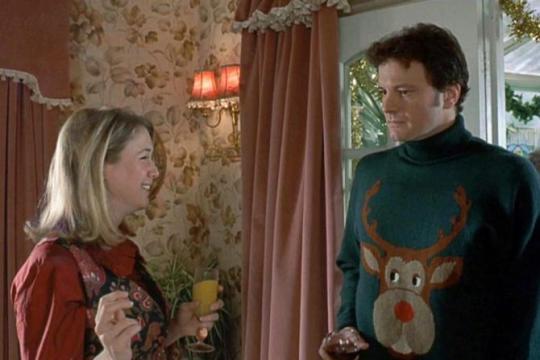
Bridget Jones' Diary (2001)
An adaptation of the book of the same name which is a contemporary reimagining of Pride and Prejudice, Bridget Jones’ Diary has Colin Firth reprising the Mr. Darcy role (here, Mark Darcy) alongside Renee Zellweger as Bridget Jones, a 32-year-old woman looking to stop smoking, lose weight, and find Mr. Right—who most definitely is not snooty barrister Mr. Darcy.
Written by Richard Curtis (Love Actually), Andrew Davies (screenwriter of the 1995 Pride and Prejudice), and source material author Helen Fielding, this script has it all: romance, comedy, and plenty of heart. The film spawned two sequels—neither of which are as good as the original, but neither of which is terrible either.

Bride & Prejudice (2004)
This Bollywood-style contemporary adaptation from Gurinder Chadha (Bend It Like Beckham) stars Aiswarya Rai as Lalita Bakshi, a young Indian woman who lives in Amritsar with her parents and three sisters. When Lalita and her sister meet British-Indian lawyer Balraj (Naveen Andrews) and well-off American Will Darcy (Martin Henderson) at a wedding, strong feelings ensue. A great cast and a fresh cultural setting make this adaptation a must-watch.

Pride & Prejudice (2005)
Basically a masterpiece, Joe Wright’s first feature film has a great cast (Kiera Knightley, Matthew Macfadyen, Rosamund Pike, Carey Mulligan, Jena Malone, Judy Dench, Talulah Riley, and Donald Sutherland), but it’s the director’s interest in getting the setting right that makes this adaptation special. Using his trademark long shot, Wright invites viewers into the world of the Bennets: from the homey, organic mess of the Bennet house to the cheerful chaos of a dance hall, Pride and Prejudice has never felt so lived-in.

Lost in Austen (2008)
If you like your Austen with a speculative fiction twist, might I recommend Lost in Austen? This 2008 ITV miniseries stars Jemima Rooper as Amanda Price, a huge Jane Austen fan who gets pulled into the world of her favorite Austen novel and must make choices accordingly. This four-part story doesn't totally stick the landing, but it's well worth the quick watch for its humor, creativity, and meta fun, as well as to see Gemma Arteron as Elizabeth Bennet.

The Lizzie Bennet Diaries (2012)
Who knew Austen was so well-suited for the vlog style? Hank Green and Bernie Su, apparently, who were the creators behind this Emmy-winning adaptation, which reimagines Elizabeth Bennet as a mass communications grad student still living at home with her parents and two sisters.
The story is told chiefly through a series of vlogs (as well as through supplementary social media accounts for the world’s characters, making this a transmedia storytelling experience). In universe, Lizzie (Ashley Clements) begins a vlog series chronicling her life as a thesis project, an event that just happens to coincide with the moving in of a wealthy medical student Bing Lee (Christopher Sean) and his even wealthier friend, William Darcy (Daniel Vincent Gordh), next door. Told in real-time over the span of year, The Lizzie Bennet Diaries was a truly special storytelling experience, and is still well-worth watching even without the real-time aspect.
Best Emma Adaptations
While slightly less well-known than Pride and Prejudice, Emma has had its fair share of on-screen adaptations. The story of the spoiled 21-year-old Emma Woodhouse, Emma follows Emma on her matchmaking adventures, which are more the ego-driven meddling of a bored, rich girl with too much time on her hands than anything else. With Emma, Austen set out to tell the story of an unlikable protagonist, but Austen never intends for us to root against her, making Emma’s realistic journey of self-growth that much more cathartic.

Clueless (1995)
If you’ve seen one Emma adaptation, it’s probably this one. A contemporary retelling of Emma Woodhouse’s story, Clueless’ reimagining of Emma as bratty Beverly Hills teen Cher is downright genius. Starring Alicia Silverstone in the main role and Paul Rudd as ex-step brother and unassuming love interest Josh, Clueless is more than just one of the best Austen adaptations out there—it’s one of the best teen comedies of all time.

Emma (2009)
If you’re looking for a faithful miniseries adaptation of Emma, we recommend this 2009 version. Starring Romola Garai as Emma, Jonny Lee Miller as Knightley, and Michael Gabon as Mr. Woodhouse, and written by Sandy Welch (who also gave us the glorious North & South adaptation), this four-part serial will give you more bang for your buck than any of the feature film adaptations.

Emma Approved (2013)
From the web series company that brought you The Lizzie Bennet Diaries comes this similarly-structured Emma adaptation. Recontextualizing Emma Woodhouse as a young lifestyle coach and matchmaking entrepreneur, Emma Approved comments on YouTube/influence culture in insightful, empathetic ways. While not as good as its predecessor, Emma Approved is still a delightful adaptation worth the watch if you're into this form of storytelling.

Emma. (2020)
Bright, colorful, and at times absurdly pretty, this highly-stylized adaptation of Emma highlights the comedy of Austen’s classic tale without sacrificing any of the drama or romance. Anya Taylor-Joy delivers a masterful performance, as we watch Emma go from the rigidly-controlled noble to a more empathetic, thoughtful version of herself, but it’s Bill Nighy and Miranda Hart in supporting roles who really get to chew the scenery.
Other Best Jane Austen Adaptations

Sense and Sensibility (1995)
Emma Thompson. Kate Winslet. Hugh Grant. Alan Rickman. Need I say more? Written by Emma Thompson and directed by Ang Lee (his first English-language feature film), this faithful adaptation of Austen's Sense and Sensibility is a classic. Whether you're a fan of the film or simply a cinephile, I highly recommend checking out Thompson's "screenplay and diary" chronicling the making of this film.
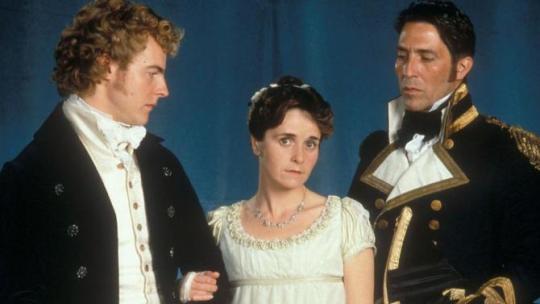
Persuasion (1995)
If you're going to go for an adaptation of Austen's final novel (published after her death), try to find this 1995 made-for-TV film. Starring Amanda Root and Ciarán Hinds as Anne and Captain Wentworth respectively (not to mention Killing Eve's Fiona Shaw as Mrs. Croft!), Persuasion is not the story of two people coming together for the first time, but two people reuniting after eight years apart. We mentioned 1995 was a good year for Austen fans, yeah?

Mansfield Park (1999)
Mansfield Park doesn't get a lot of love when it comes to the adaptation, but this 1999 film starring Frances O'Connor and Jonny Lee Miller is one of the best Jane Austen-inspired films out there. A looser adaptation of the novel that also incorporates elements of Jane Austen's life into the story, Mansfield Park has all of the swoon-worthy romance, sharp social commentary, and relatable female protagonist you could want from an Austen adaptation.
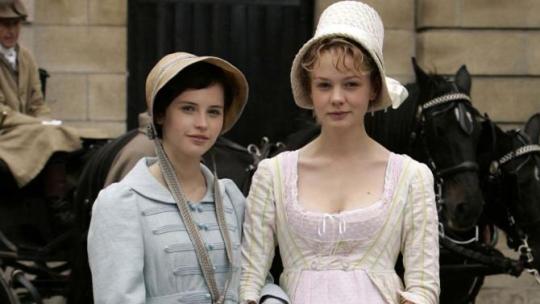
Northanger Abbey (2007)
Andrew Davies is back at it again with this 2007 television movie, starring Felicity Jones as protagonist Catherine Morland (Carey Mulligan also pops up as friend Isabella Thorpe). One of the OG stories about fandom, Northanger Abbey follows young, naive Catherine as she visits Bath, becomes the object of two men's affections, and begins to confuse real life with the kind of things that might happen in the Gothic romance novels she obsessively reads. If you've never engaged with this most meta of Austen's works, we recommend checking out this adaptation.

From Mansfield With Love (2014)
If you're a fan of the vlog diaries adaptation format (if you can't tell by now, I am), then I also recommend this endearing adaptation of Mansfield Park. Created by Foot in the Door Theatre, what this production lacks in budget, it makes up for in heart. From Mansfield With Love reimagines the story of 19th-century protagonist Fanny Price to modern-day Britain where Frankie Price is working as a housekeeper at a hotel owned by the Bertrams. In an effort to keep in touch with her brother Will, she begins to send video diaries chronicling her life at Mansfield and with the Bertram family, in particularly with friend Edmund. Austen has never felt so real.

Love and Friendship (2016)
Austen in the style of Armando Iannucci (this film is actually written and directed by indie filmmaker Whit Stillman), Love and Friendship is an adaptation of Austen's epistolary novel Lady Susan, which follows the recently-widowed Lady Susan (Kate Beckinsale, having so much fun) in her efforts to secure advantageous marriages for both herself and her daughter.

Sanditon (2019)
The new kid on the block, Sanditon just wrapped up its first (and hopefully not only) season on PBS. Based on the unfinished Austen novel, it follows country gentlewoman Charlotte Heywood (Rose Williams) into the relatively more exciting world of Sanditon, a fishing village with aspirations of being a seaside resort.
While Sanditon isn't without its indulgent plotting, it is beautiful to look at, and includes some memorable performances from Theo James, Charlotte Spencer, and a massively underutilized Crystal Clarke, playing a rare character of color in Austen adaptations. More than anything, it's interesting to see Andrew Davies (yep, he's back) extrapolating out Austen's unfinished novel. Perhaps, fittingly, we most likely will never find out what happens next in this on-screen adaptation.
What is you favorite Austen adaptation? Let us know in the comments below...
Kayti Burt is a staff editor covering books, TV, movies, and fan culture at Den of Geek. Read more of her work here or follow her on Twitter @kaytiburt.
facebook
twitter
tumblr

The Lists Kayti Burt
Books
Feb 26, 2020
from Books https://ift.tt/2HYLtkM
17 notes
·
View notes
Photo

Upcoming Shows Through January 2020
We’re pleased to announce our advance schedule of exhibitions through January 2020, including a retrospective featuring the futurist fashion of Pierre Cardin; a solo presentation of work by internationally recognized artist JR; and the reinstallation of the Museum's Arts of Japan and China collections. In addition, and in collaboration with the Château de Malmaiso, France, in January 2020 the iconic Kehinde Wiley painting from the Brooklyn Museum's collection—Napoleon Leading the Army over the Alps (2005)—will be on view in dialogue with its early nineteenth-century source painting, Jacques-Louis David's Napoleon Crossing the Alps (1800-1801).
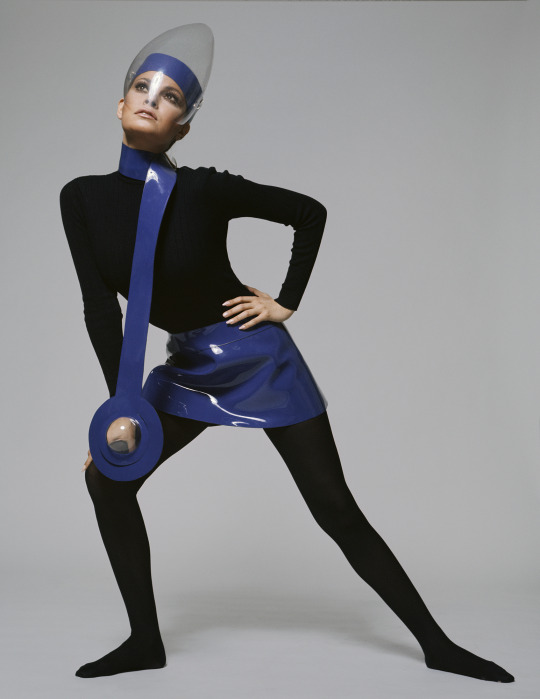
Pierre Cardin: Future Fashion
July 20, 2019-January 5, 2020
Morris A. and Meyer Schapiro Wing and Iris and B. Gerald Cantory Gallery, 5th Floor
The retrospective exhibition Pierre Cardin: Future Fashion traces the legendary career of one of the fashion world's most innovative designers, one whose futuristic designs and trailblazing efforts to democratize high fashion for the masses pushed the boundaries of the industry for more than seven decades. Featuring over 170 objects that date from the 1950s to the present, the exhibition includes haute couture and ready-to-wear garments, accessories, photographs, film, and other materials drawn primarily from the Pierre Cardin archive. Highlights range across rare designs in luxury fabrics from the 1950s; a large grouping from the landmark 1964 "Cosmocorps" collection; creations that incorporate vinyls, plastics, and the self-named "Cardine" synthetic fabric; signature unisex ensembles featuring full knit bodysuits with layered skirts, vests, bibs, and jewelry; iconic broad-shouldered jackets from the 1980s based on Japanese origami, Chinese architecture, and American football uniforms; "illuminated" jumpsuits and dresses; and an extensive overview of Cardin's recently designed couture menswear and eveningwear. The exhibition reveals how the designer's bold, futuristic aesthetic had a pervasive influence not only on fashion, but on other forms of design that extended beyond clothing to furniture, industrial design, and more.
Pierre Cardin: Future Fashion is curated and designed by Matthew Yokobosky, Senior Curator of Fashion and Material Culture, Brooklyn Museum. Leadership support for this exhibition is provided by Chargeurs.
Terry O'Neill (British, born 1938). Raquel Welch in a Pierre Cardin outfit featuring a miniskirt and necklace in blue vinyl, worn with a Plexiglas visor, 1970. Image courtesy of Iconic Images. © Terry O'Neill / Iconic Images

JR: Chronicles
October 4, 2019-May 3, 2020
Great Hall, 1st Floor
We’re pleased to present JR: Chronicles, the French artist's largest solo museum exhibition to date. The presentation covers nearly 20,000 square feet of our Great Hall and traces JR's artistic evolution since 2001, focusing on his commitment to community and civic discourse through the use of large-scale media such as news and advertising as well as architectural interventions. Working at the intersections of photography, social practice, and street art, JR's participatory projects have fostered collaborations and conversations around the globe. The exhibition centers on The Chronicles of New York City, a new monumental mural incorporating the portraits and stories of over one thousand New Yorkers. The immersive installation also features JR's most well-known works across photography, installation, film, and video from the past fifteen years, including his first major collaborative project, Portrait of a Generation (2004-6); Face 2 Face (2007), which features giant portrait diptychs of Israelis and Palestinians, face to face, in eight Palestinian and Israeli cities; Women Are Heroes (2008-9), featuring images of the eyes of women gazing back at their communities in numerous countries, including Brazil, India, and Kenya; the global participatory art project Inside Out (2011-ongoing); and The Gun Chronicles: A Story of America (2018), a video mural that gives a face to the full and complex spectrum of views on guns in the United States.
JR: Chronicles is curated by Sharon Matt Atkins, Director of Curatorial Affairs, and Drew Sawyer, Phillip Leonian and Edith Rosenbaum Leonian Curator, Photography, Brooklyn Museum.
JR (French, born 1983). The Chronicles of New York City (detail), 2018-19. Dimensions variable. © JR-ART.NET

Arts of China
Opens October 25, 2019
Arts of Asia and the Middle East, 2nd Floor
Our comprehensive collection of Chinese art spans more than five thousand years of Chinese artistic accomplishment, and boasts a diversity of art forms including jades, bronzes, lacquer, sculpture, painting, and calligraphy. This fall, we open our newly reinstalled galleries for our renowned Arts of China collection, featuring recent acquisitions, new commissions, and rarely seen historical treasures. Our large collection of cloisonné enamels, many from the Chinese imperial collection, are featured, along with masterpieces of bronze such as a Shang dynasty ritual vessel (gong) and a Han dynasty goose. Also on view are a selection of ceramics, including our world-famous Yuan dynasty Wine Jar with Fish and Aquatic Plants, widely acknowledged to be one of the finest blue-and-white porcelains in the Western hemisphere.
Since 2014, we have worked to expand our holdings of contemporary painting and sculpture by Chinese artists, culminating in the acquisition of over fifty works from the twentieth and twenty-first centuries, including new commissions that spark dialogue with objects from our historical collection. Highlights include experimental ink painting by Sun Xun, Zheng Chongbin, Tai Xiangzhou, Zhang Jian-Jun, Bingyi, Peng Wei, and others.
Arts of China is curated by Susan L. Beningson, Assistant Curator, Asian Art, Brooklyn Museum.
Wine Jar with Fish and Aquatic Plants. China. Yuan dynasty, 1279-1368. Porcelain with underglaze cobalt blue decoration, 111 5/16 x 13 3/4 in. (30.3 x 34.9 cm). Brooklyn Museum, The William E. Hutchins Collection, Bequest of Augustus S. Hutchins, 52.87.1. (Photo: Brooklyn Museum)

Arts of Japan
Opens October 25, 2019
Arts of Asia and the Middle East, 2nd Floor
This fall, we unveil a new gallery for our Arts of Japan collection following a multiyear renovation. In this inaugural installation, seventy objects from our collection illustrate the sophistication of Japanese art-making technologies and explore the dialogue between tradition and innovation in Japan. Featuring masterworks of Buddhist sculpture, vivid Ukiyo-e prints, exquisite screen paintings, and cutting-edge contemporary ceramics, the gallery highlights two thousand years of artistic achievement. In acknowledgement of the cultural diversity within the region, the installation also includes highlights from our important collection of artifacts from the Ainu people of northern Japan, material that is rarely shown in an art museum setting
Arts of Japan is curated by Joan Cummins, Lisa and Bernard Selz Senior Curator, Asian Art, Brooklyn Museum.
Head of Guardian. Japan. Kamakura period (1185-1333), 13th century. Hinoki wood with polychrome, inlaid rock crystal eyes, filigree metal crown, 22 1/16 x 10 1/4 x 13 15/16 in. (56 x 26 x 35.4 cm). Brooklyn Museum, Gift of Mr. and Mrs. Alastair B. Martin, the Guennol Collection, 86.21. (Photo: Brooklyn Museum)
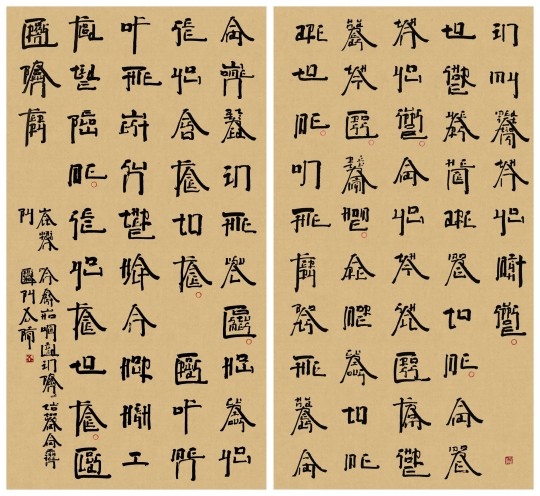
One: Xu Bing
October 25, 2019-April 26, 2020
Focus Gallery, 2nd Floor
Focusing on a major new gift to our world-renowned collection of Chinese art, One: Xu Bing highlights the painting Square Word Calligraphy: Crossing Brooklyn Ferry, Walt Whitman (2018). Created specifically for the Brooklyn Museum in consultation with curator Susan L. Beningson, this painting by one of China's most important living artists celebrates Xu Bing's close relationship with Brooklyn, where he lived in the 1990s and still has a studio today. Square Word Calligraphy: Crossing Brooklyn Ferry, Walt Whitman pays homage to Walt Whitman, the famous American poet, who served as an early librarian at the Brooklyn Apprentices' Library Association (our predecessor). His now-iconic poem "Crossing Brooklyn Ferry" is part of his collection Leaves of Grass and celebrates the idea that all of us are united in our shared human experience. 2019 marks Whitman's 200th birthday, and this exhibition includes material from our Archives to celebrate his relationship to the Museum.
Xu Bing (b. 1955) developed Square Word Calligraphy as a new way of rendering the English language after he came to New York in the early 1990s. The hybrid calligraphy incorporates English words in rectangular arrangements that resemble Chinese characters. This interplay between form and language reflects Xu Bing's experience in New York, where he lived between two cultures.
One: Xu Bing is curated by Susan L. Beningson, Assistant Curator, Asian Art, Brooklyn Museum.
Xu Bing (Chinese, born 1955). Square Word Calligraphy: Crossing Brooklyn Ferry, Walt Whitman, 2018. Ink on paper, 89 3/8 x 48 13/16 in. (227 x 124 cm). Brooklyn Museum, Gift of Xu Bing to the Brooklyn Museum in honor of his father, 2018.24a-b. (Photo: Courtesy of the artist)


Jacques-Louis David Meets Kehinde Wiley
January 24-May 10, 2020
Morris A. and Meyer Schapiro Wing, 4th Floor
Jacques-Louis David Meets Kehinde Wiley brings an iconic painting from our collection—Kehinde Wiley's Napoleon Leading the Army over the Alps (2005)—into dialogue with its early nineteenth-century source painting, Jacques-Louis David's Napoleon Crossing the Alps (1800-1801). The two paintings, displayed together for the very first time, are on view in consecutive exhibitions at the Château de Malmaison from October 9, 2019 to January 6, 2020, and at the Brooklyn Museum from January 24 to May 10, 2020. The exhibition questions how ideas of race, masculinity, representation, power, heroics, and agency play out within the realm of portraiture. The Brooklyn presentation marks the first display of David's painting in New York, and Wiley helps highlight this momentous occasion by consulting on the exhibition design. Video also accompanies the project, incorporating Wiley's perspectives on how the Western canon, French portrait tradition, and legacies of colonialism influence his own practice. The exhibition represents an intimate conversation between two key artists of the nineteenth and twenty-first centuries and illuminates how images construct history, convey notions of power and leadership, and monumentalize figures in the form of aggrandizing icons.
The exhibition is organized by the Brooklyn Museum and Musée national des châteaux de Malmaison and Bois-Préau. The Brooklyn presentation is curated by Lisa Small, Senior Curator, European Art, and Eugenie Tsai, John and Barbara Vogelstein Senior Curator, Contemporary Art, Brooklyn Museum.
Kehinde Wiley (American, born 1977). Napoleon Leading the Army over the Alps, 2005. Oil on canvas, 108 x 108 in. (274.3 x 274.3 cm). Brooklyn Museum, Partial gift of Suzi and Andrew Booke Cohen in memory of Ilene R. Booke and in honor of Arnold L. Lehman, Mary Smith Dorward Fund, and William K. Jacobs, Jr. Fund, 2015.53. © Kehinde Wiley. (Photo: Brooklyn Museum)
Jacques-Louis David (French, 1748-1825). Napoleon Crossing the Alps (Bonaparte franchissant le Grand-Saint-Bernard), 1801. Oil on canvas, 102 1/3 x 87 in. (261 x 221 cm). Collection of Château de Malmaison. (Photo: Courtesy RMN-GP)
Top image: Pierre Cardin two-tone jersey dresses, with vinyl waders, 1969. (Photo:Yoshi Takata. © Pierre Pelegry)
#PierreCardinBKM#Pierre Cardin#jr#chineseart#japaneseart#onexubing#xubing#kehindewiley#davidxwiley#jacques louis david#brooklyn#exhibitions#nyc#art#bkmcontemporary#bkmeuropeanart#artsofjapan#artsofchina
51 notes
·
View notes